Kyoto is more than just a famous travel destination; it's a living museum filled with hidden spiritual traditions that offer a deeper connection to Japan's ancient soul, beyond its well-known temples and bamboo groves. I discovered the true essence of the city through experiences like the Chinowa Kuguri rituals for purification, passing through the Stone of Transformation at Yasui Kompiragū Shrine to sever negative ties and invite good fortune, participating in communal sacred circle ceremonies at Azumamaro Shrine, and meditating while walking through the thousands of vermillion gates of Senbon Torii.
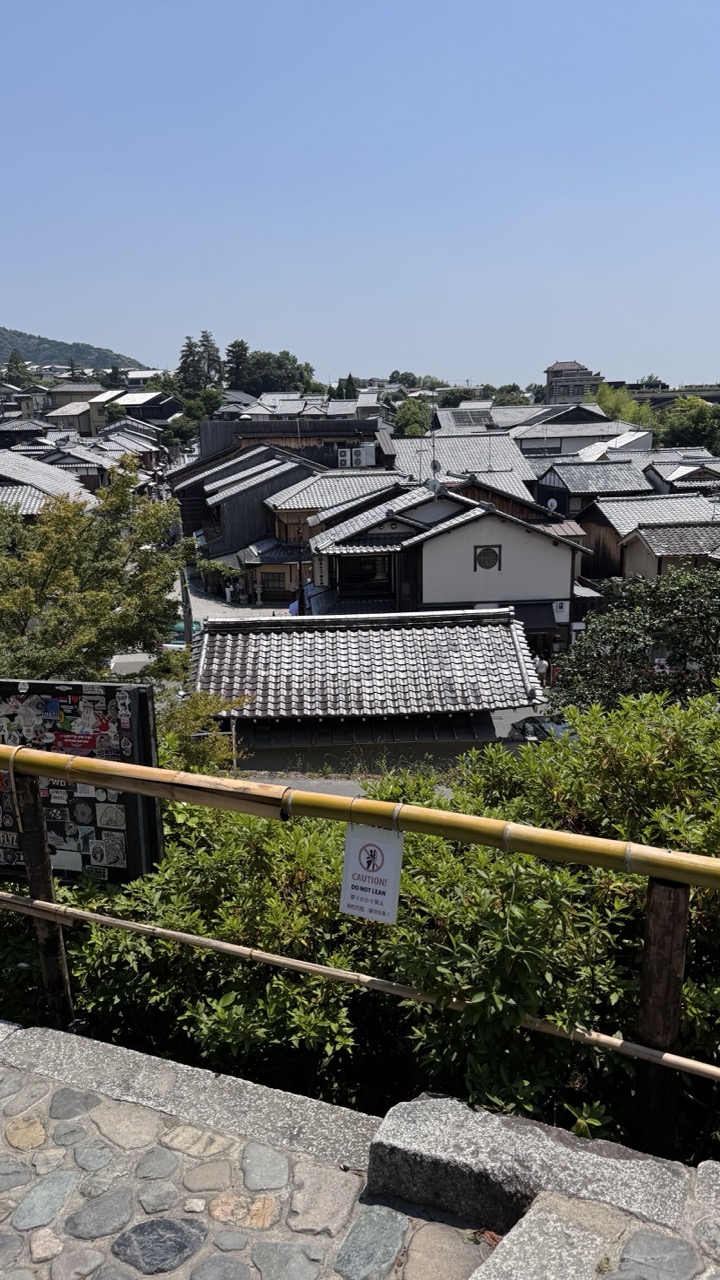

1. Overall Rating (0–10) — 7.0
This photograph captures the timeless charm of a traditional Japanese neighborhood under a clear blue sky, where historic architecture unfolds in a layered tapestry of tiled roofs and wooden facades. The composition is grounded by a natural, earthy foreground that leads the eye into the scene, though the modern signage and bamboo railing subtly disrupt the historical ambiance. The image succeeds in conveying a sense of place—quiet, lived-in, and steeped in cultural heritage—yet feels slightly restrained by its documentary approach.
2. Composition (0–10) — 7.5
The diagonal line of the bamboo railing creates a natural leading line, guiding the viewer’s gaze into the dense cluster of rooftops. The placement of the foreground elements frames the scene effectively, while the balance between the lush greenery and the built environment adds depth.
3. Lighting (0–10) — 8.0
Bright, natural daylight illuminates the scene with clarity and evenness, enhancing the textures of the tiles and stone. The strong overhead sun casts minimal shadows, creating a clean, open feel that complements the crispness of the sky.
4. Color & Tone (0–10) — 7.5
The palette is harmonious, dominated by the warm grays of the tiles, the lush greens of the foliage, and the pale blue of the sky. The contrast between the natural tones and the man-made elements adds visual interest without appearing jarring.
5. Creativity (0–10) — 6.5
While the scene is inherently picturesque, the image leans toward a straightforward travel photograph rather than a deeply interpretive or conceptual work. The inclusion of the "Do Not Lean" sign introduces a subtle narrative tension, but the overall execution remains observational.
6. Technical Quality (0–10) — 8.5
The image is sharp and well-focused, with excellent clarity in both the foreground and background. The exposure is balanced, and the detail in the textures—stone, wood, and tile—is rendered with precision.
7. Emotional Impact (0–10) — 7.0
The photograph evokes a sense of calm and nostalgia, inviting the viewer to imagine life in a quiet, historic district. The blend of tradition and subtle modernity creates a reflective mood, though the emotional resonance is tempered by the image’s documentary nature.
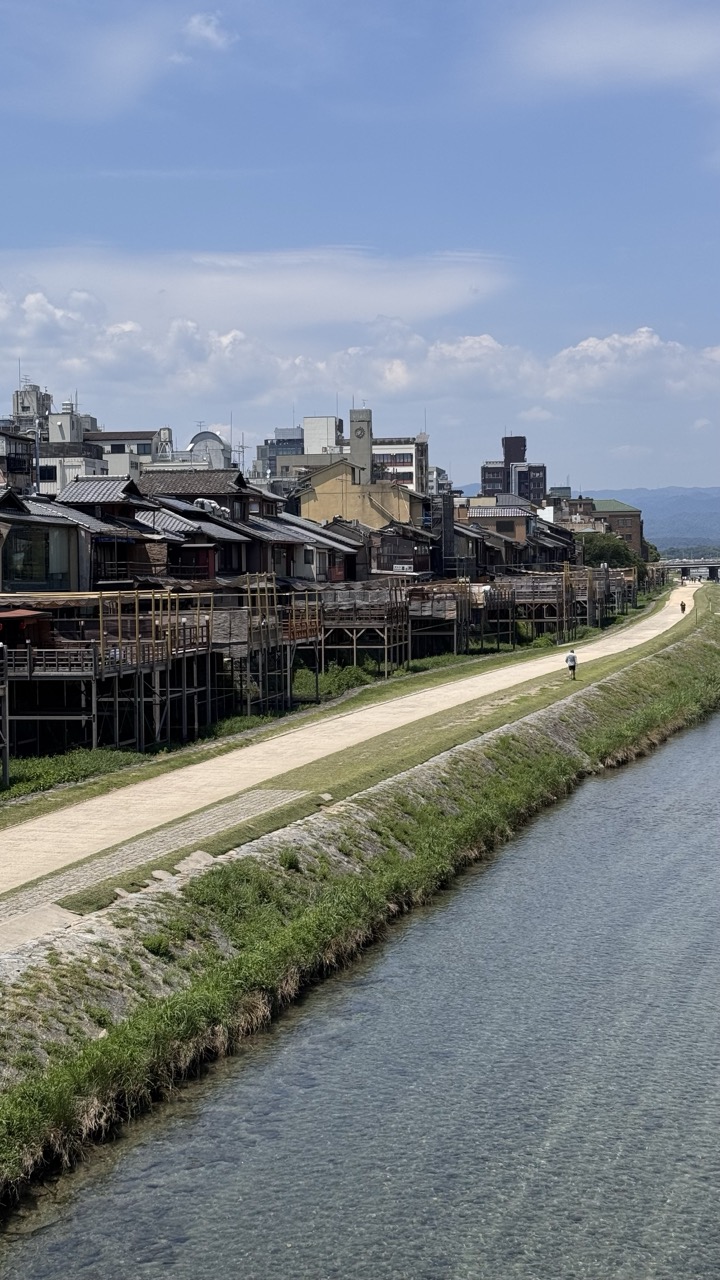

1. Overall Rating (0–10) — 7.0
This photograph captures a serene riverside scene where traditional wooden structures meet modern city life under a vast, cloud-dappled sky. The juxtaposition of historic architecture along the riverbank with distant high-rises creates a compelling narrative of continuity and change. While the image is visually balanced and rich in detail, the slightly overexposed sky and muted tones prevent it from achieving a more dramatic emotional resonance.
2. Composition (0–10) — 7.5
The diagonal flow of the river and path draws the eye naturally through the frame, leading from the foreground to the distant cityscape. The placement of the traditional buildings along the left and the open sky above create a strong sense of depth and balance.
3. Lighting (0–10) — 6.5
Bright daylight illuminates the scene evenly, but the sky appears slightly washed out, reducing contrast and atmospheric texture. The light enhances the clarity of the water and structures, though it lacks the warmth or directionality that would add mood.
4. Color & Tone (0–10) — 6.0
The palette is dominated by soft blues, greens, and earthy browns, creating a calm, natural atmosphere. However, the colors feel somewhat desaturated, giving the image a flat appearance that undercuts its visual potential.
5. Creativity (0–10) — 7.0
The image successfully captures a moment where tradition and modernity coexist, offering a narrative beyond mere documentation. The perspective and framing suggest a deliberate intent to highlight cultural continuity within an evolving urban landscape.
6. Technical Quality (0–10) — 7.5
The image is sharp and clear, with good focus on the buildings and water. The exposure is generally well-handled, though the sky's brightness slightly compromises detail in the clouds.
7. Emotional Impact (0–10) — 6.5
The scene evokes a quiet contemplation of time and place—of people moving through a space shaped by history and change. While the emotional pull is subtle, it lingers in the viewer’s mind as a peaceful reflection on urban life.
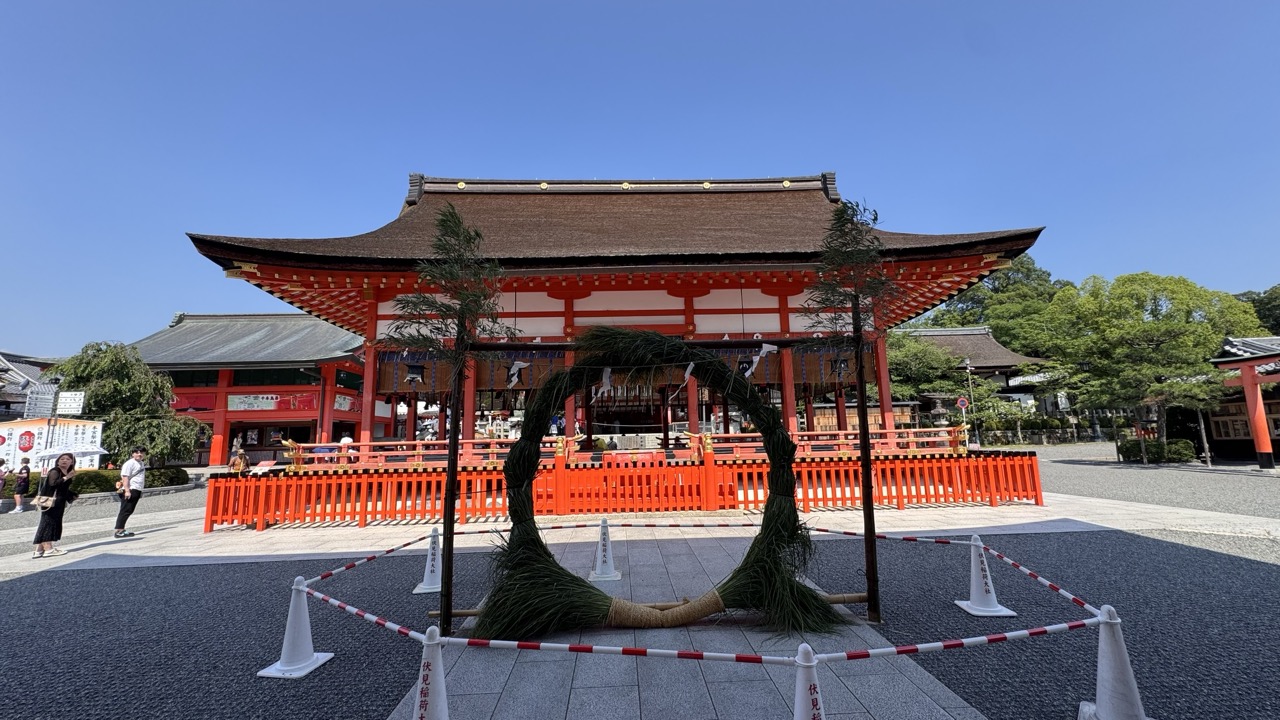

1. Overall Rating (0–10) — 7.0
This photograph captures the vibrant energy of a traditional Japanese shrine under a brilliant blue sky, where the bold red of the architecture contrasts strikingly with the lush greenery and crisp sunlight. The presence of the *shimenawa* (rice straw rope) in the foreground adds cultural depth and a sense of ritual, while the casual visitors lend a human scale to the grand setting. Though the composition is strong, the wide-angle perspective slightly flattens the scene’s depth, and the foreground barriers, while functional, disrupt the visual flow.
2. Composition (0–10) — 6.5
The shrine is centered with strong symmetry, creating a balanced and formal composition. However, the foreground elements—particularly the *shimenawa* and the red-and-white barriers—introduce visual clutter that slightly undermines the harmony.
3. Lighting (0–10) — 8.5
The bright, direct sunlight enhances the vividness of the reds and the clarity of the blue sky, casting clean shadows that add dimension and emphasize the architectural lines.
4. Color & Tone (0–10) — 8.0
The color palette is rich and harmonious, with the deep red of the shrine contrasting beautifully against the sky and green foliage. The tones are warm and saturated, reinforcing the sunny, celebratory atmosphere.
5. Creativity (0–10) — 7.5
The image thoughtfully incorporates cultural elements—like the *shimenawa* and the shrine’s traditional design—into a contemporary travel photograph. It balances documentation with artistic intent, suggesting a moment of reverence within daily life.
6. Technical Quality (0–10) — 8.0
The image is sharp and well-exposed, with clear detail in both the foreground and background. The wide dynamic range preserves texture in the wood and stone, and the focus is consistently accurate across the scene.
7. Emotional Impact (0–10) — 7.0
The photograph evokes a sense of peace and cultural awe, inviting the viewer to feel the stillness and significance of the sacred space. The presence of people adds a subtle warmth, grounding the scene in human experience.
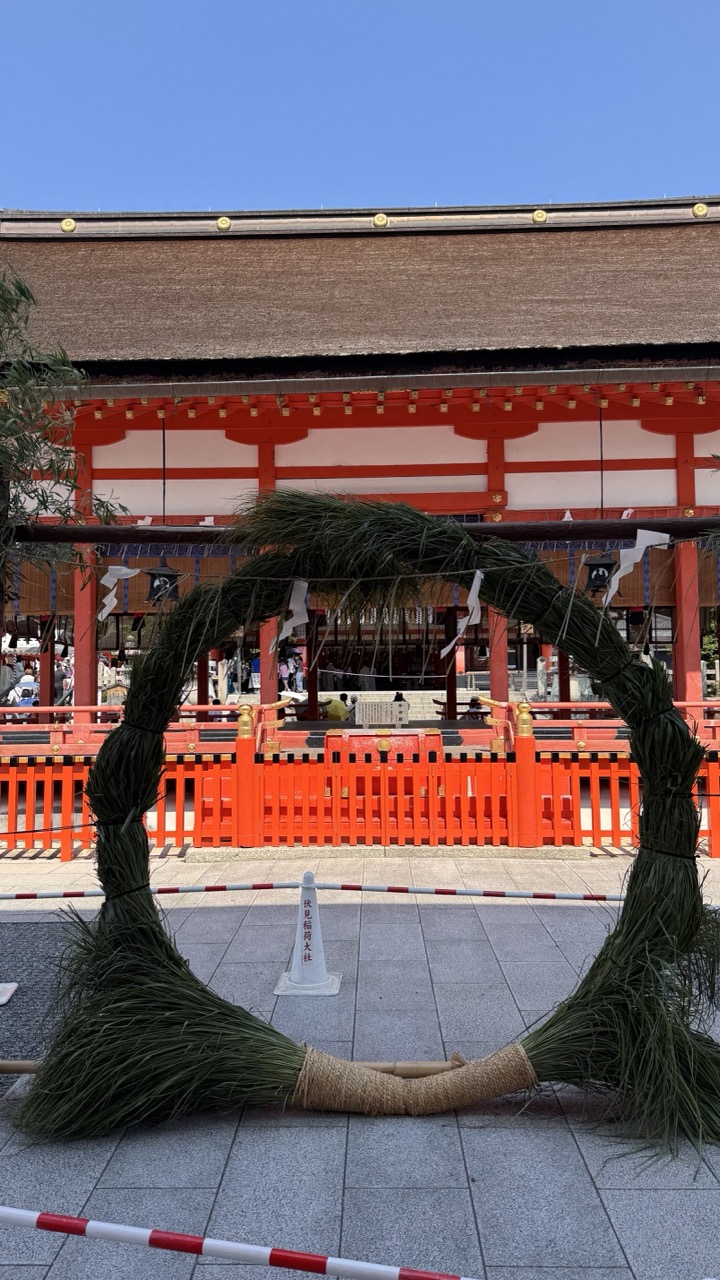

1. Overall Rating (0–10) — 7.0
This photograph captures the serene grandeur of a traditional Japanese shrine, where cultural symbolism meets architectural elegance. The bold red of the torii and the natural texture of the straw wreath create a striking contrast against the clear blue sky, evoking a sense of reverence and timelessness. While the composition is strong and the subject culturally rich, the presence of modern barriers and signage slightly disrupts the spiritual atmosphere, grounding the image in the present day.
2. Composition (0–10) — 7.5
The straw wreath frames the shrine effectively, creating a natural focal point that draws the eye toward the central structure. The symmetry of the torii and the balanced placement of the wreath enhance visual harmony, though the low-angle perspective slightly compresses the depth of the scene.
3. Lighting (0–10) — 8.0
Bright, natural daylight enhances the vividness of the red and green tones, casting soft shadows that define the architecture’s form. The clear sky provides a clean, uncluttered backdrop, allowing the colors and textures to stand out with clarity.
4. Color & Tone (0–10) — 8.0
The contrast between the vibrant vermilion and the deep green of the wreath is visually arresting, complemented by the neutral gray pavement and crisp blue sky. The palette feels authentic and culturally resonant, with balanced saturation that enhances the image’s traditional aesthetic.
5. Creativity (0–10) — 7.0
The use of the straw wreath as a framing device is both symbolic and visually compelling, adding a layer of cultural narrative. While the concept is well-executed, it leans more on established traditions than on innovative visual storytelling.
6. Technical Quality (0–10) — 8.0
The image is sharp and well-focused, with clear detail in both the foreground and background. The exposure is balanced, and the resolution captures fine textures in the thatched roof and woven straw.
7. Emotional Impact (0–10) — 7.5
The photograph evokes a sense of peace and reverence, inviting the viewer into a space of quiet contemplation. The juxtaposition of tradition and modernity—marked by the barrier and signage—adds a subtle tension, grounding the spiritual scene in a recognizable, lived reality.
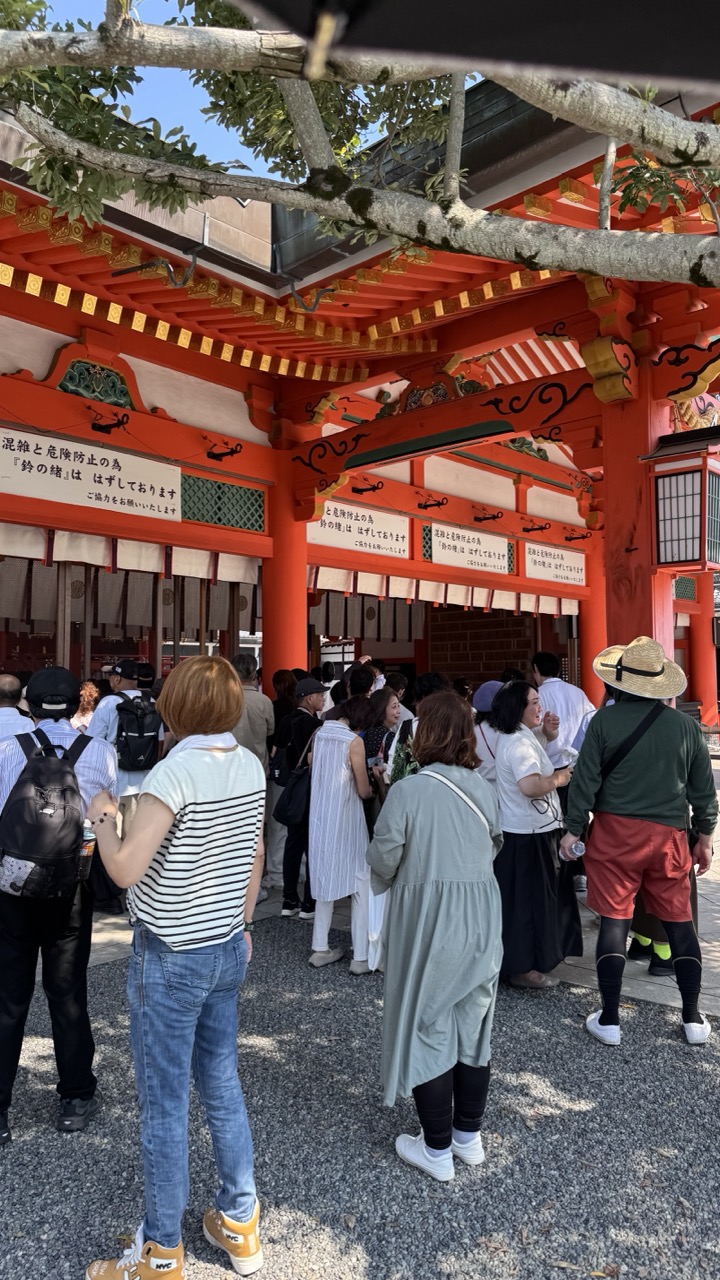

1. Overall Rating (0–10) — 7.0
This photograph captures the vibrant energy of a bustling Japanese shrine, where tradition and modern life intersect under a bright, sunlit sky. The rich red of the torii structure contrasts beautifully with the natural textures of tree branches and gravel, creating a dynamic and culturally resonant scene. While the crowd adds a sense of authenticity, the composition’s slight clutter and framing choices prevent it from achieving greater visual harmony.
2. Composition (0–10) — 6.0
The framing feels slightly off-center and cluttered, with the overhanging tree branch drawing attention away from the main subject. A tighter composition focusing on the shrine entrance and the queue would enhance visual clarity.
3. Lighting (0–10) — 8.0
Bright, natural daylight illuminates the scene evenly, highlighting the vivid reds and architectural details. The shadows are soft and well-defined, adding depth without obscuring key elements.
4. Color & Tone (0–10) — 7.0
The dominant red of the shrine creates a bold, energetic palette, complemented by the natural greens of the tree and the varied neutral tones of the visitors’ clothing. The color balance is strong, though the overall warmth could be slightly enhanced to heighten the atmosphere.
5. Creativity (0–10) — 6.5
The image effectively documents a moment of cultural engagement, capturing both the architectural beauty and the human presence. While the concept is grounded and authentic, the lack of a unique visual angle limits its artistic distinction.
6. Technical Quality (0–10) — 7.5
The image is sharp and well-exposed, with clear details in both the background architecture and the foreground figures. Focus is consistent, and there are no visible technical flaws.
7. Emotional Impact (0–10) — 6.5
The photograph evokes a sense of community and reverence, capturing the quiet rhythm of daily ritual. While the emotional resonance is present, the viewer remains slightly distanced by the crowded, observational nature of the shot.
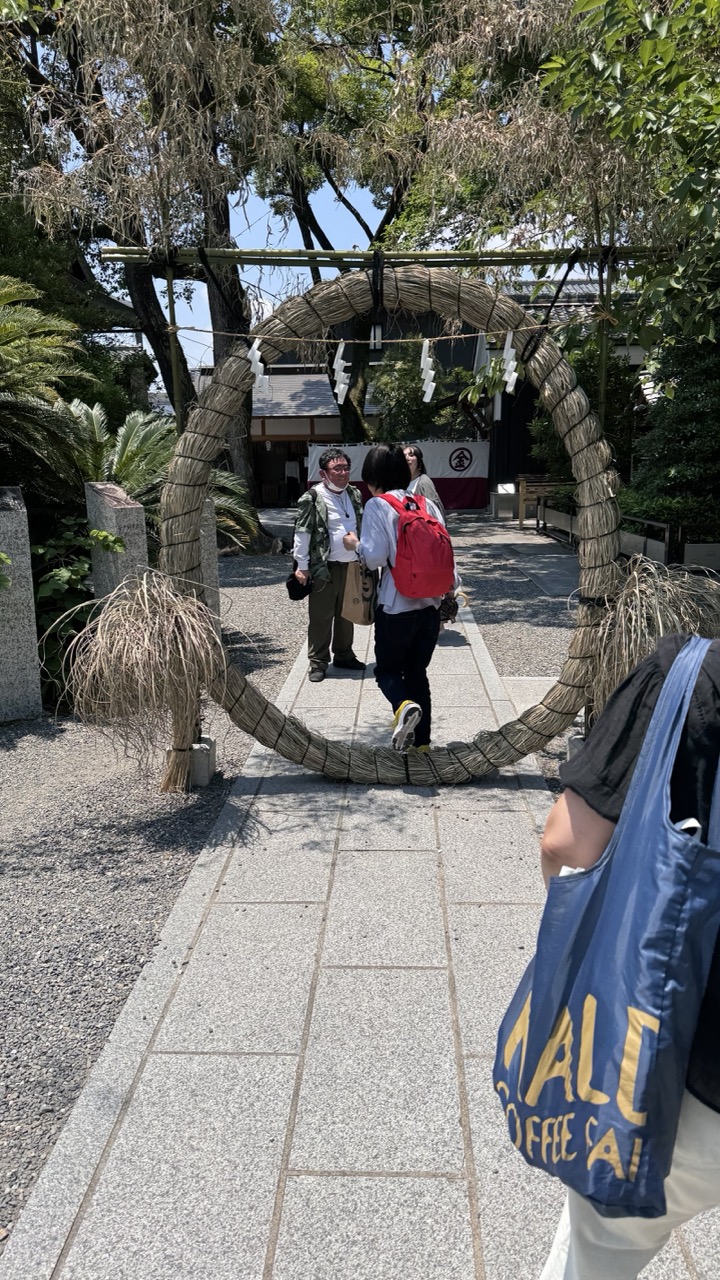

1. Overall Rating (0–10) — 6.0
This photograph captures a quiet moment at a traditional Japanese shrine, where the woven straw torii and natural surroundings evoke a sense of cultural reverence. The composition draws the eye through the circular frame, creating a narrative of passage and ritual, though the casual presence of modern visitors and a branded tote bag slightly disrupts the sacred atmosphere. The image succeeds in documenting a real, lived-in space, but lacks the visual cohesion to feel fully immersive.
2. Composition (0–10) — 6.5
The circular torii acts as a strong framing device, guiding the viewer’s gaze toward the figures walking through it. The diagonal path and foreground elements create depth, but the asymmetrical placement of the bag and the partial obstruction by the person on the right slightly weaken the balance.
3. Lighting (0–10) — 7.0
Natural daylight illuminates the scene evenly, with soft shadows indicating a bright but overcast or filtered sun. The lighting enhances the textures of the straw and stone, adding clarity without harsh contrast.
4. Color & Tone (0–10) — 6.5
The palette is dominated by earthy browns, greens, and grays, reflecting the natural and traditional setting. The red backpack and blue tote add pops of color that draw attention, though their modern branding slightly clashes with the cultural context.
5. Creativity (0–10) — 6.0
The use of the torii as a compositional frame is effective and conceptually sound, suggesting a journey or transition. However, the inclusion of contemporary elements like the tote bag and casual clothing introduces a juxtaposition that feels more documentary than artistic.
6. Technical Quality (0–10) — 7.5
The image is sharp and well-focused, with clear detail in the textures of the straw, stone, and foliage. The exposure is balanced, and there are no obvious technical flaws.
7. Emotional Impact (0–10) — 5.5
The photograph conveys a sense of quiet observance and cultural continuity, but the presence of modern elements and the lack of a clear emotional focal point prevent a deeper connection. It feels more like a snapshot than a powerful evocation of place.
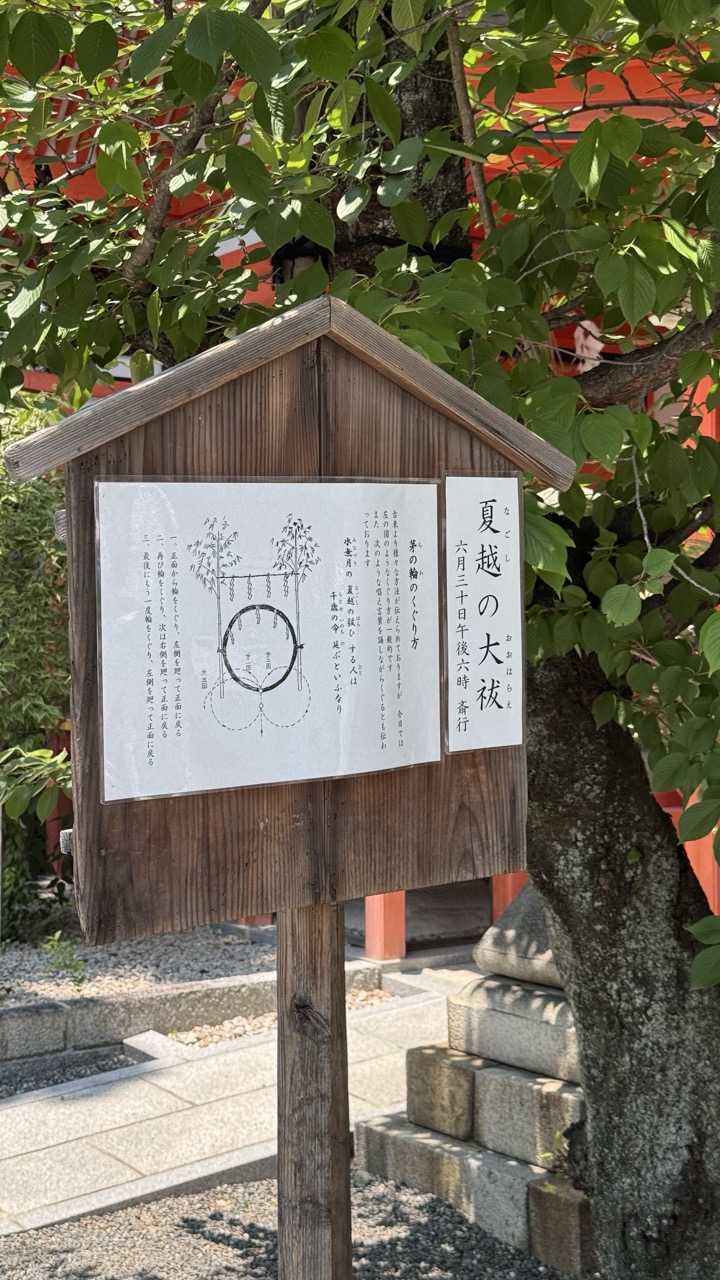

1. Overall Rating (0–10) — 7.0
This photograph captures a serene moment at a Japanese shrine, where nature and tradition harmonize in quiet dignity. The wooden sign, inscribed with cultural instructions and illustrated with a diagram, serves as both an informative guide and a visual anchor, grounding the scene in ritual and place. While the composition is balanced and the lighting natural, the image feels more like a documentation than a compelling artistic statement—its strength lies in its authenticity, but it lacks a strong emotional or aesthetic pull.
2. Composition (0–10) — 7.0
The sign is centered with a strong vertical alignment, framed by the tree’s foliage and the red shrine in the background. The diagonal of the tree trunk adds visual interest, while the gravel path and stone steps lead the eye into the frame, creating a layered sense of depth.
3. Lighting (0–10) — 7.5
Natural daylight bathes the scene with soft, even illumination, enhancing the textures of the wood and leaves. The interplay of light and shadow through the canopy adds depth without creating harsh contrasts, supporting the tranquil mood.
4. Color & Tone (0–10) — 7.0
The palette is harmonious, with the earthy brown of the sign, the vibrant green of the leaves, and the subtle red of the shrine in the background creating a balanced, culturally resonant palette. The tones are natural and unmanipulated, lending an organic quality to the image.
5. Creativity (0–10) — 6.5
The photograph is conceptually grounded in cultural documentation, with the sign’s text and diagram offering narrative depth. While the image is not overtly experimental, its strength lies in capturing a quiet moment of everyday tradition, inviting contemplation of ritual and place.
6. Technical Quality (0–10) — 8.0
The image is sharp and well-focused, with clear details in the wood grain, text, and foliage. The exposure is balanced, and there are no visible artifacts or distractions.
7. Emotional Impact (0–10) — 6.5
The image evokes a sense of calm and reverence, inviting the viewer to pause and consider the rituals being described. While the emotional resonance is subtle, the cultural context and natural setting combine to create a meditative and reflective atmosphere.
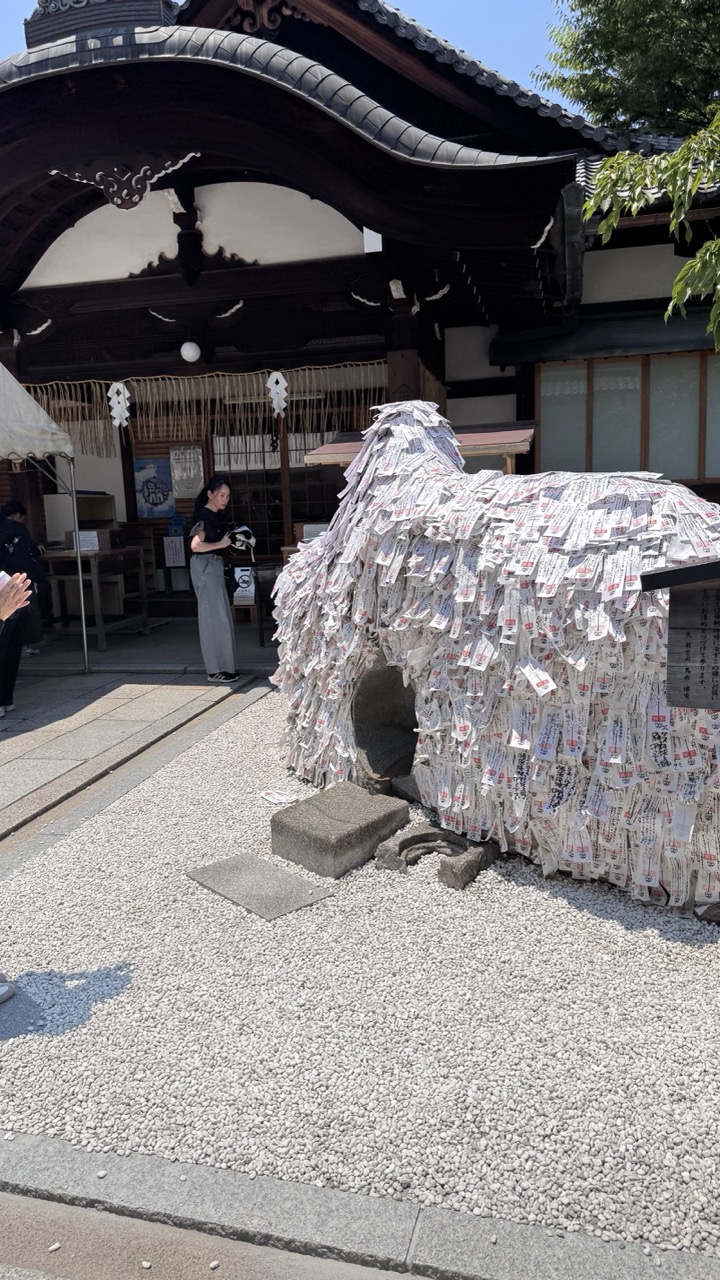

1. Overall Rating (0–10) — 7.0
This photograph captures a quiet moment at a Japanese shrine, where tradition and modern life intersect through the presence of a woman observing a uniquely adorned structure. The juxtaposition of the weathered wooden temple and the whimsical, paper-covered sculpture creates a compelling narrative about cultural continuity and contemporary expression. While the image is rich in context, the slightly awkward framing and flat lighting prevent it from achieving greater visual impact.
2. Composition (0–10) — 6.0
The composition is slightly off-center, with the paper-covered sculpture dominating the right side and a woman positioned awkwardly in the left background. The low angle and uneven placement of foreground elements like the gravel and stones disrupt visual balance, though the architectural lines of the temple provide some structural cohesion.
3. Lighting (0–10) — 6.5
The bright daylight creates strong shadows and highlights, emphasizing the texture of the gravel and the intricate details of the paper-covered structure. However, the harsh overhead sun flattens the scene’s depth and casts distracting shadows, reducing the overall atmospheric quality.
4. Color & Tone (0–10) — 6.0
The palette is dominated by neutral tones—grays, whites, and the dark wood of the temple—creating a subdued, almost monochromatic effect. The red accents on the paper tags offer a subtle pop of color, but the overall lack of tonal variation tempers the image’s visual richness.
5. Creativity (0–10) — 7.5
The concept of covering a stone structure with hundreds of paper tags is both inventive and culturally resonant, blending ritual with artistic expression. The photograph captures this unique tradition with authenticity, suggesting a deeper story behind the visual spectacle.
6. Technical Quality (0–10) — 7.5
The image is sharp and well-focused, with clear details visible in both the foreground and background. The camera’s focus on the central sculpture is accurate, and there are no significant technical flaws in exposure or clarity.
7. Emotional Impact (0–10) — 6.5
The image evokes a sense of quiet reverence and curiosity, inviting the viewer to reflect on the intersection of faith, tradition, and modernity. While the emotional resonance is present, the distant framing and lack of intimate detail keep the viewer from fully connecting with the moment.
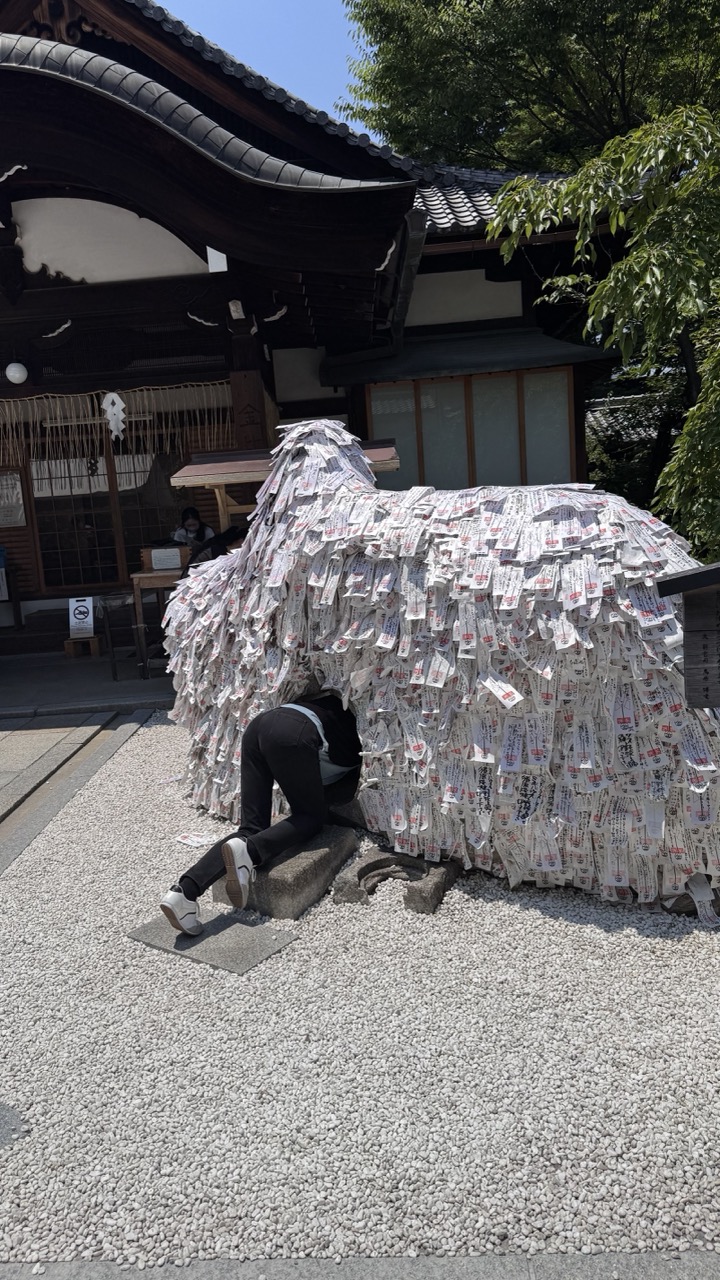

1. Overall Rating (0–10) — 7.0
This photograph captures a striking juxtaposition between tradition and contemporary ritual, centered around a uniquely adorned shrine object covered in votive slips. The person crouching beneath it adds a human scale and narrative layer, suggesting both reverence and playful interaction. While the image's composition and lighting are strong, the clutter of the paper slips slightly overwhelms the visual clarity, softening the impact of the cultural detail.
2. Composition (0–10) — 6.5
The subject is well-framed, with the shrine structure providing a strong architectural backdrop that grounds the scene. The crouching figure draws the eye and adds narrative tension, though the low angle and slight tilt create a sense of imbalance that distracts from the symmetry of the setting.
3. Lighting (0–10) — 8.0
Bright, natural daylight enhances the clarity and texture of the scene, casting sharp shadows that emphasize the depth of the paper slips and the gravel surface. The sunlight highlights the contrast between the white slips and the dark temple roof, contributing to a vivid, sun-drenched atmosphere.
4. Color & Tone (0–10) — 6.0
The palette is dominated by whites, grays, and the dark tones of the temple, creating a subdued, almost monochromatic effect. While the colors are true to life, they lack vibrancy, and the red accents on the slips are too small to provide visual contrast or emotional punch.
5. Creativity (0–10) — 7.5
The image presents an original and culturally rich moment—transforming a traditional setting into a site of participatory art through the accumulation of votive slips. The act of crouching beneath the structure adds a layer of interpretive play, inviting questions about ritual, belief, and the intersection of public and private devotion.
6. Technical Quality (0–10) — 7.5
The image is sharp and well-exposed, with good detail in both the foreground and background. Focus is consistent across the subject, and the high resolution captures the texture of the paper and gravel effectively.
7. Emotional Impact (0–10) — 6.5
The scene evokes a sense of quiet wonder and cultural curiosity, with the human interaction adding a touch of intimacy and whimsy. While the emotional resonance is strong in context, the image may feel more like an ethnographic snapshot than a deeply moving portrait.
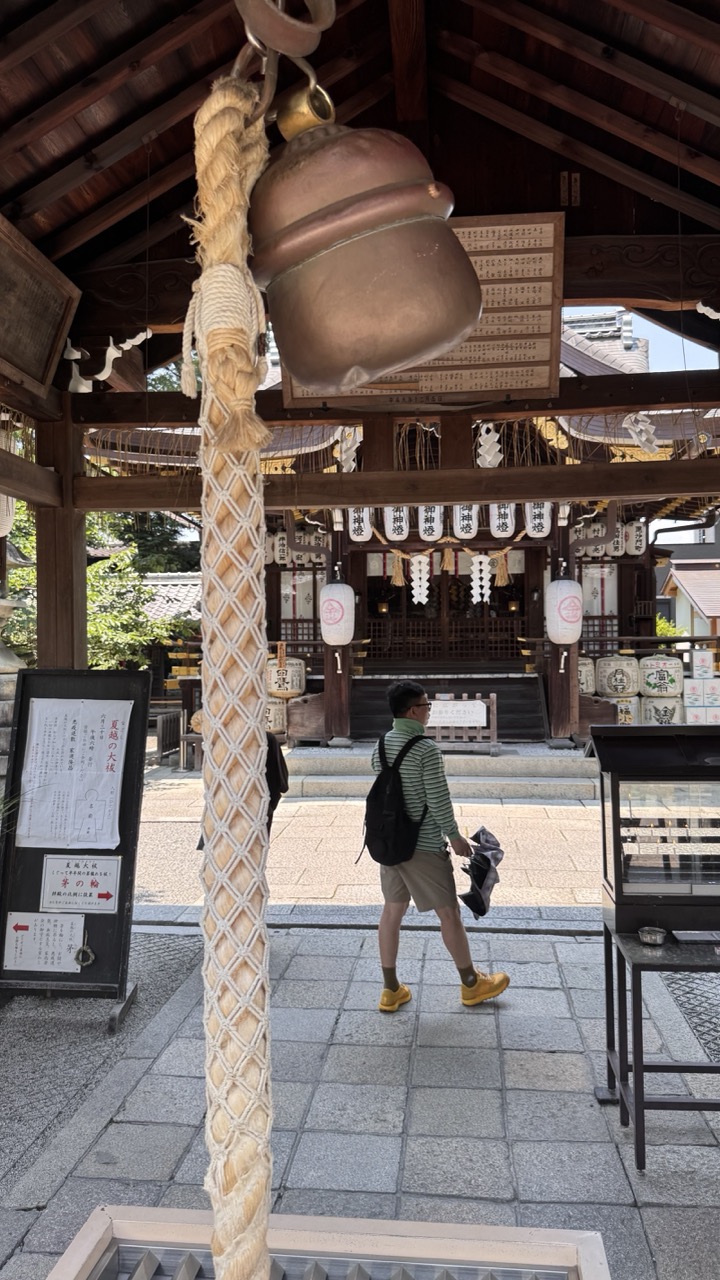

1. Overall Rating (0–10) — 7.0
This photograph captures the quiet reverence of a Japanese shrine, where tradition and daily life intersect in a moment of stillness. The foreground rope and bell create a strong visual anchor, drawing the eye through the frame toward the shrine’s sacred space, while the casually dressed visitor adds a human element that grounds the scene in reality. The image balances cultural authenticity with a sense of intimacy, though the composition’s slight asymmetry and cluttered signage slightly undermine its visual harmony.
2. Composition (0–10) — 6.5
The rope in the foreground provides depth and leads the viewer’s eye toward the shrine, but the placement of the man and the information board creates a slightly unbalanced frame. A tighter crop might improve focus and reduce distractions.
3. Lighting (0–10) — 7.0
Natural daylight illuminates the scene evenly, highlighting textures in the rope and wood while maintaining a soft, warm tone. The shadows are gentle, enhancing the tranquil atmosphere without overwhelming the details.
4. Color & Tone (0–10) — 7.0
The palette is harmonious, dominated by earthy browns, muted grays, and the subtle gold of the bell, with a soft contrast between the wooden structure and the white lanterns. The yellow shoes add a subtle pop of color that draws attention without disrupting the scene’s serenity.
5. Creativity (0–10) — 7.0
The photographer captures a quiet narrative—between ritual and routine—through a carefully framed moment. The juxtaposition of the sacred object (the bell) with the everyday visitor creates a layered, contemplative story that feels both personal and universal.
6. Technical Quality (0–10) — 7.5
The image is sharp and well-focused, with clear details in the rope, bell, and background structures. The exposure is balanced, and the depth of field effectively separates foreground from background without losing clarity.
7. Emotional Impact (0–10) — 7.0
There is a quiet sense of peace and introspection in the image, enhanced by the lone figure moving through a sacred space. It invites the viewer to pause and reflect on the intersection of tradition, spirituality, and modern life.
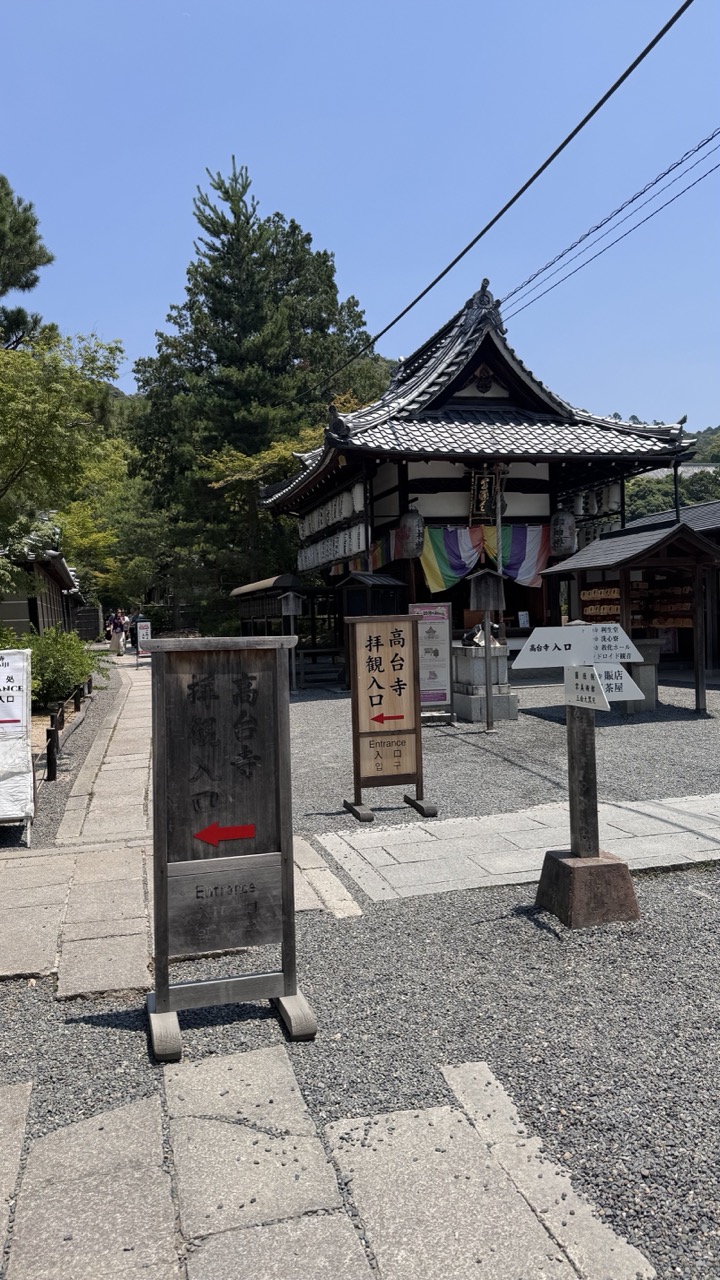

1. Overall Rating (0–10) — 7.0
This photograph captures the tranquil entrance to a traditional Japanese temple under a clear blue sky, evoking a sense of cultural reverence and peaceful anticipation. The composition draws the eye toward the temple’s entrance, with directional signs adding narrative context, though the scene’s realism is slightly diminished by the presence of modern overhead wires. The image balances documentary honesty with aesthetic appeal, offering a moment of quiet contemplation amid a living cultural landscape.
2. Composition (0–10) — 7.0
The diagonal path and layered signs create a strong sense of depth and direction, guiding the viewer toward the temple. The slightly asymmetrical framing adds dynamism, though the overhead wires disrupt the visual harmony.
3. Lighting (0–10) — 8.0
Bright, natural daylight enhances clarity and texture, casting soft shadows that define the forms of the buildings and gravel path. The high contrast between the blue sky and dark roof tiles adds visual energy.
4. Color & Tone (0–10) — 7.0
The palette is grounded in earthy tones—grays, browns, and greens—with the vibrant blue sky and colorful prayer flags offering striking accents. The color balance feels natural, though the saturation is modest, preserving authenticity.
5. Creativity (0–10) — 6.5
The image captures a familiar scene with clarity and intention, but its strength lies more in documentation than in artistic reinterpretation. The juxtaposition of tradition and modernity—through wires and signage—adds subtle narrative depth.
6. Technical Quality (0–10) — 7.5
The photograph is sharp and well-exposed, with clean focus across the frame. The detail in the wooden signs and stone pavement demonstrates strong technical execution.
7. Emotional Impact (0–10) — 6.5
The image conveys calm and reverence, inviting quiet reflection. While not emotionally charged, it effectively communicates the stillness of a sacred space on a bright, sunlit day.
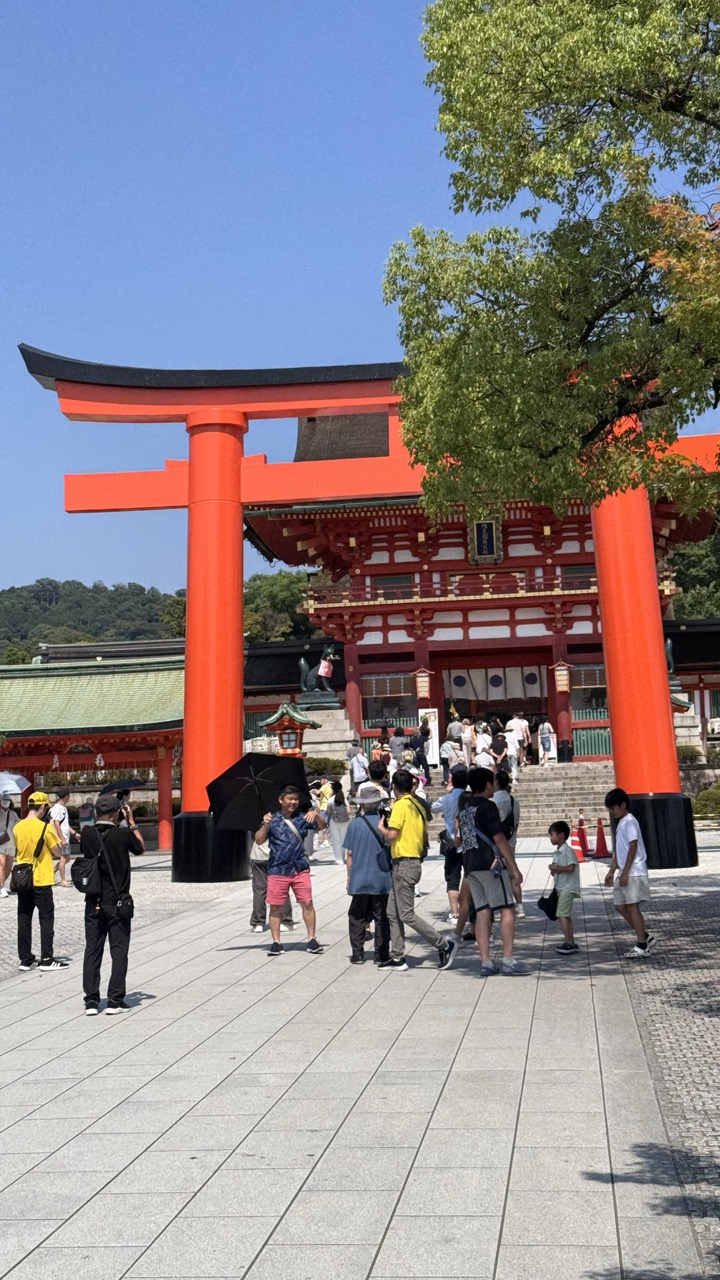

1. Overall Rating (0–10) — 7.0
This photograph captures the vibrant energy of a bustling shrine entrance under a clear blue sky, where tradition and modern life intersect. The bold red torii gate dominates the frame, drawing the eye toward the temple beyond, while the crowd of visitors adds a sense of scale and human warmth. Though the scene is rich in cultural context, the composition feels slightly overwhelmed by the number of people, and the bright daylight flattens some of the architectural details, slightly diminishing the image’s visual depth.
2. Composition (0–10) — 6.5
The torii gate is well-centered, creating a strong focal point, but the wide-angle perspective includes too much foreground clutter, distracting from the temple’s grandeur. The tree on the right balances the frame but also cuts into the sky, slightly disrupting the horizontal harmony.
3. Lighting (0–10) — 7.5
The bright, direct sunlight enhances the vividness of the red torii and creates crisp shadows, adding dimension to the scene. However, the harsh overhead light flattens some textures and casts deep shadows under the gate, reducing detail in the lower portions of the image.
4. Color & Tone (0–10) — 8.0
The contrast between the striking vermilion of the gate and the deep blue sky is powerful and visually arresting. The green of the tree adds a natural complement, while the neutral pavement tones keep the focus on the primary colors. The overall palette is rich and harmonious, enhancing the image’s cultural resonance.
5. Creativity (0–10) — 7.0
The image successfully captures a moment of everyday pilgrimage at a famous site, offering a sense of place and activity. While not particularly inventive in its approach, it tells a clear story of tourism and reverence, grounding the viewer in the experience of visiting the shrine.
6. Technical Quality (0–10) — 8.0
The image is sharp and well-focused, with clean detail throughout. The exposure is well-balanced, avoiding significant overexposure despite the bright daylight. The wide-angle lens effectively captures the scene’s scale without introducing noticeable distortion.
7. Emotional Impact (0–10) — 6.5
The photograph conveys a sense of awe and serenity, underscored by the grandeur of the shrine and the peaceful presence of visitors. However, the sheer number of people and the lack of a single human focal point keep the emotional connection from feeling deeply personal or intimate.
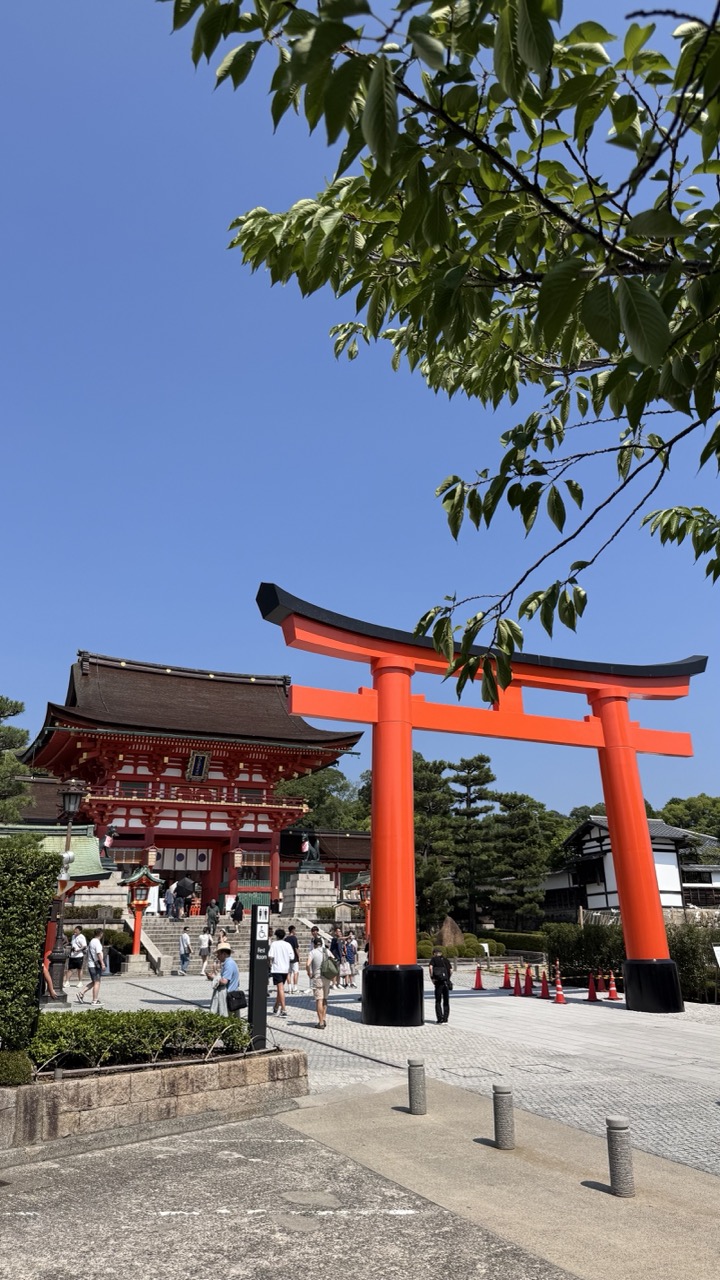

1. Overall Rating (0–10) — 8.0
This photograph captures the vibrant energy of a traditional Japanese shrine under a brilliant blue sky, where the bold red of the torii gate stands as a powerful visual anchor. The composition draws the eye naturally from the foreground foliage to the sacred architecture, creating a sense of depth and cultural reverence. While the scene is bustling with visitors, the clarity and color saturation enhance the image’s appeal, though a more deliberate framing could have elevated its artistic impact.
2. Composition (0–10) — 7.5
The low-angle perspective emphasizes the grandeur of the torii and the shrine, while the diagonal branch in the upper right adds a natural framing element. The placement of the gate slightly off-center creates visual interest, though the inclusion of the pavement and bollards in the foreground slightly disrupts the harmony.
3. Lighting (0–10) — 9.0
Bright, direct sunlight enhances the vividness of the red torii and the deep blue sky, casting crisp shadows that define form and structure. The high contrast and clear illumination contribute to a sense of clarity and vitality.
4. Color & Tone (0–10) — 8.5
The rich vermilion of the torii contrasts strikingly with the azure sky and the green foliage, creating a harmonious and balanced palette. The warm tones of the wooden shrine and the cool background create a dynamic interplay, enhancing the image’s visual appeal.
5. Creativity (0–10) — 7.0
While the subject is iconic and the composition effective, the image functions more as a strong documentary capture than a deeply original interpretation. The use of natural framing and color contrast shows thoughtful execution, but the familiar viewpoint limits its conceptual innovation.
6. Technical Quality (0–10) — 8.5
The image is sharp, well-exposed, and free of noticeable technical flaws. The focus is precise, and the dynamic range handles both the bright sky and shaded areas effectively.
7. Emotional Impact (0–10) — 7.5
The photograph evokes a sense of awe and cultural reverence, inviting the viewer to feel the spiritual significance of the space. The presence of visitors adds a human element, grounding the scene in lived experience and creating a connection to tradition and place.
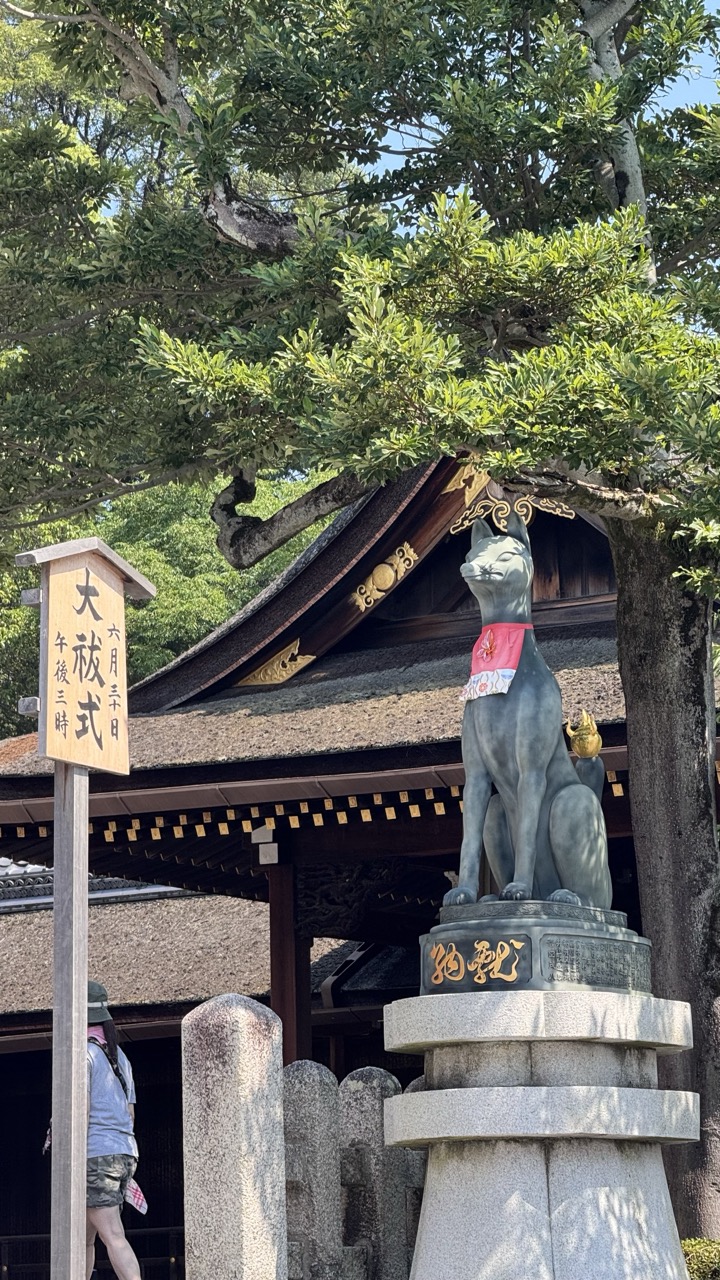

1. Overall Rating (0–10) — 7.0
This photograph captures the serene presence of a traditional Japanese shrine, centered around a striking fox statue—a symbol of Inari, the deity of rice and prosperity. The interplay of natural light filtering through the trees and the rich textures of stone, wood, and thatch lends the scene a quiet authenticity. While the composition is slightly cluttered by the sign and background elements, the image successfully conveys a sense of cultural reverence and stillness.
2. Composition (0–10) — 6.5
The fox statue is well-positioned as the focal point, but the inclusion of the wooden sign and the partial figure on the left introduces visual distractions. A tighter crop or repositioning could improve balance and emphasize the statue’s symbolic importance.
3. Lighting (0–10) — 7.5
Natural daylight illuminates the scene with a soft, dappled quality, creating gentle highlights and shadows that enhance texture. The sunlight filtering through the canopy adds depth and a sense of time, grounding the image in a warm, midday atmosphere.
4. Color & Tone (0–10) — 7.0
The palette is rich with earthy tones—deep greens, browns, and the gray of the stone—punctuated by the red of the fox’s bib, which draws the eye. The contrast between the vibrant foliage and the subdued shrine architecture creates a harmonious visual rhythm.
5. Creativity (0–10) — 6.5
The image is grounded in realism, capturing a moment of cultural life rather than abstract expression. However, the symbolic weight of the fox and the shrine offers a quiet narrative depth that elevates the photograph beyond mere documentation.
6. Technical Quality (0–10) — 7.5
The image is sharp and well-focused, with clear details in both the statue and the surrounding architecture. The exposure is balanced, and the depth of field effectively isolates the main subject from the background.
7. Emotional Impact (0–10) — 6.5
The photograph evokes a sense of calm and spiritual quiet, inviting the viewer to pause and reflect on tradition and nature. While the emotional resonance is restrained by the scene’s everyday context, the image still conveys a subtle reverence for place and practice.


1. Overall Rating (0–10) — 7.0
This photograph captures the vibrant energy of a bustling Japanese shrine, where tradition and modern life intersect under a bright, sunlit sky. The rich red of the torii structure contrasts beautifully with the natural textures of tree branches and gravel, creating a dynamic and culturally resonant scene. While the crowd adds a sense of authenticity, the composition’s slight clutter and framing choices prevent it from achieving greater visual harmony.
2. Composition (0–10) — 6.0
The framing feels slightly off-center and cluttered, with the overhanging tree branch drawing attention away from the main subject. A tighter composition focusing on the shrine entrance and the queue would enhance visual clarity.
3. Lighting (0–10) — 8.0
Bright, natural daylight illuminates the scene evenly, highlighting the vivid reds and architectural details. The shadows are soft and well-defined, adding depth without obscuring key elements.
4. Color & Tone (0–10) — 7.0
The dominant red of the shrine creates a bold, energetic palette, complemented by the natural greens of the tree and the varied neutral tones of the visitors’ clothing. The color balance is strong, though the overall warmth could be slightly enhanced to heighten the atmosphere.
5. Creativity (0–10) — 6.5
The image effectively documents a moment of cultural engagement, capturing both the architectural beauty and the human presence. While the concept is grounded and authentic, the lack of a unique visual angle limits its artistic distinction.
6. Technical Quality (0–10) — 7.5
The image is sharp and well-exposed, with clear details in both the background architecture and the foreground figures. Focus is consistent, and there are no visible technical flaws.
7. Emotional Impact (0–10) — 6.5
The photograph evokes a sense of community and reverence, capturing the quiet rhythm of daily ritual. While the emotional resonance is present, the viewer remains slightly distanced by the crowded, observational nature of the shot.
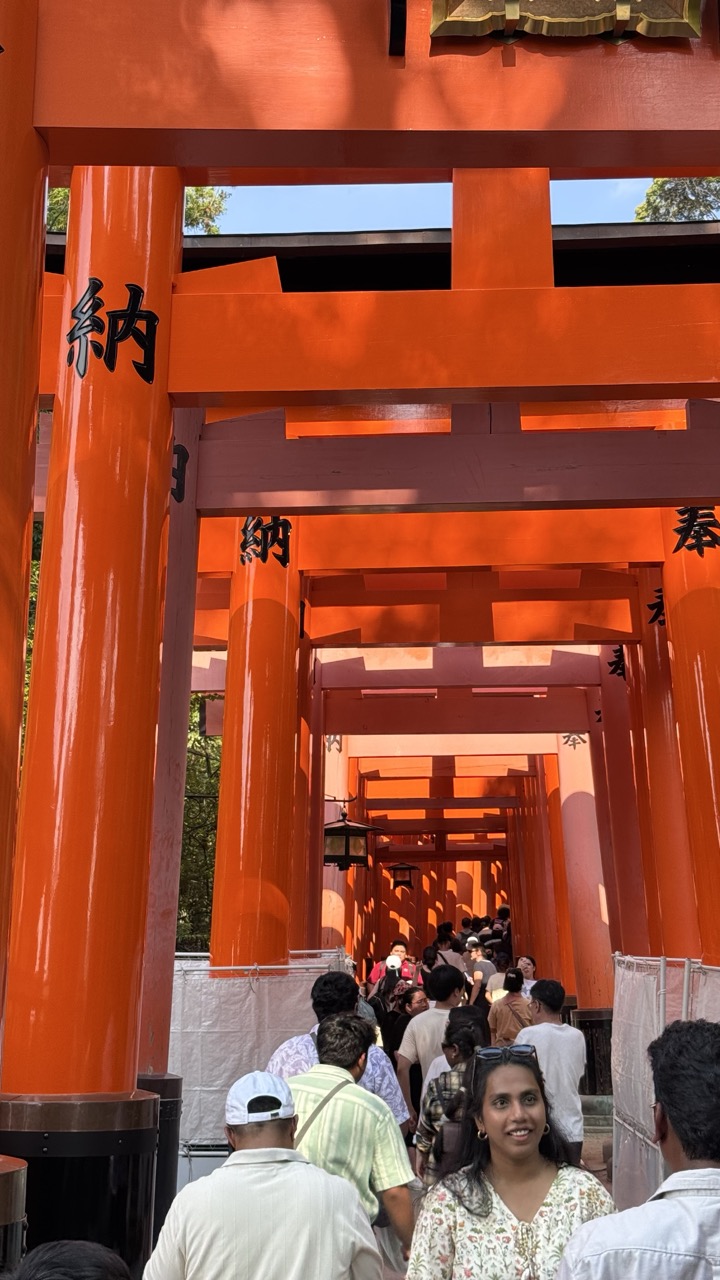

1. Overall Rating (0–10) — 7.5
This photograph captures the iconic vermilion torii gates of Fushimi Inari Shrine, where vibrant color and repeating forms create a powerful visual rhythm. The composition draws the viewer’s eye deep into the tunnel of gates, evoking a sense of journey and spiritual passage. While the image is rich in cultural resonance and color, the presence of numerous visitors slightly disrupts the sacred atmosphere, grounding the scene in the reality of tourism.
2. Composition (0–10) — 8.0
The repeating arches create strong leading lines that guide the eye into the depth of the frame, with the crowd adding narrative context. The central alignment of the gates enhances symmetry, though the inclusion of foreground figures slightly disrupts the visual flow.
3. Lighting (0–10) — 7.5
Natural daylight highlights the glossy texture of the vermilion paint, creating rich reflections and contrast. The bright sky visible between the gates adds depth and a sense of openness, while shadows beneath the structures add dimension.
4. Color & Tone (0–10) — 9.0
The bold, saturated orange of the torii gates dominates the palette, creating a striking and harmonious visual effect. The contrast between the warm reds and the cool blue sky enhances the image’s vibrancy and emotional intensity.
5. Creativity (0–10) — 7.0
The image leverages a well-known subject with strong visual appeal, using repetition and perspective to create a compelling composition. While the concept is familiar, the execution captures the essence of the location with clarity and impact.
6. Technical Quality (0–10) — 8.0
Sharp focus and good exposure reveal fine details in the wood grain and inscriptions. The camera angle and framing are deliberate, enhancing the sense of depth and immersion.
7. Emotional Impact (0–10) — 7.0
The image conveys a sense of awe and wonder, evoking the spiritual significance of the site while also reflecting the shared human experience of pilgrimage. The smiling woman in the foreground adds a personal, welcoming touch, bridging the gap between tradition and modernity.
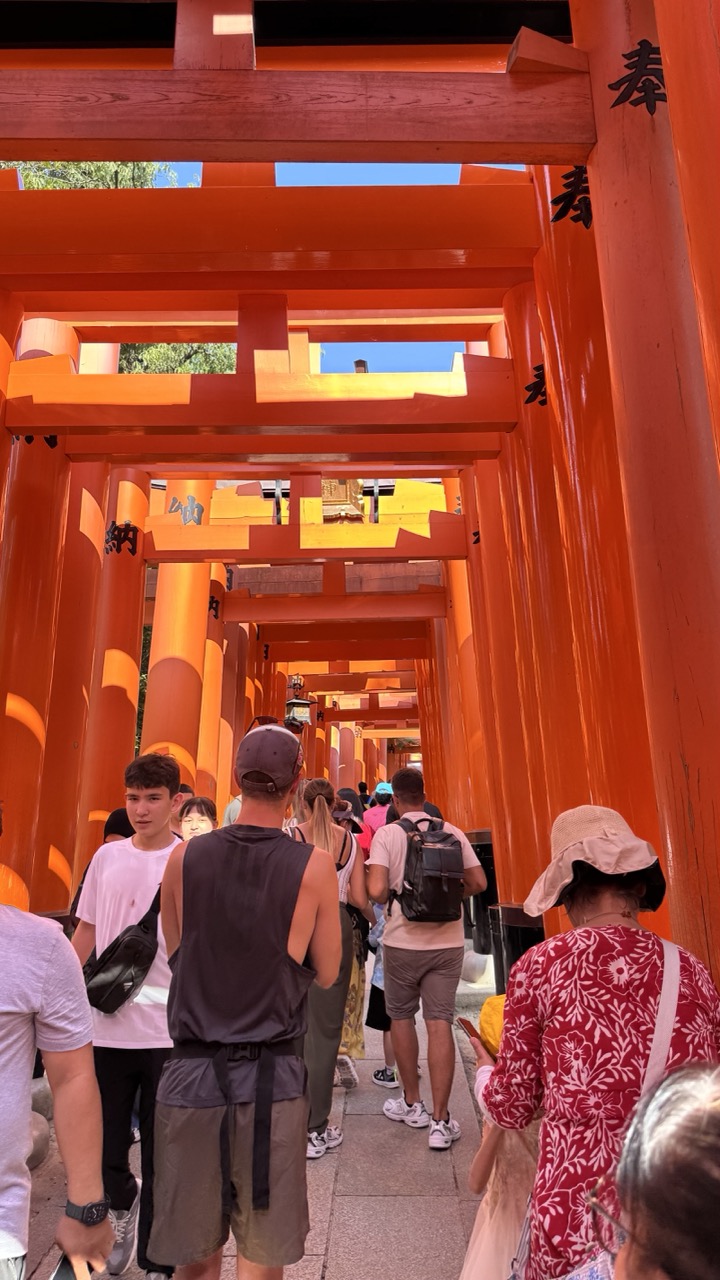

1. Overall Rating (0–10) — 7.0
This photograph captures the vibrant energy of a bustling pilgrimage path, where the repetition of vermilion torii gates creates a powerful sense of depth and rhythm. The bold color and dynamic crowd convey both spiritual significance and the everyday presence of tourism. While the image is visually striking, its strength lies in its authenticity—its slightly cluttered framing and candid nature lend it an unpolished charm, though a more refined composition could elevate its artistic impact.
2. Composition (0–10) — 6.5
The repeating arches create a strong leading line, drawing the eye toward the vanishing point, though the inclusion of too many people and foreground distractions slightly disrupts the visual flow.
3. Lighting (0–10) — 7.5
Bright, direct sunlight enhances the vividness of the orange gates and casts crisp shadows, creating contrast that emphasizes the structure’s form and depth.
4. Color & Tone (0–10) — 8.0
The dominant vermilion hue is rich and saturated, creating a bold, energetic palette that contrasts beautifully with the blue sky and earthy tones of the visitors' clothing.
5. Creativity (0–10) — 7.0
The use of the torii gate tunnel as a visual motif is both traditional and compelling, capturing the intersection of cultural reverence and modern tourism in a distinctive way.
6. Technical Quality (0–10) — 7.5
The image is sharp and well-exposed, with good detail in both the foreground and background, though some overexposure in the sky slightly diminishes tonal range.
7. Emotional Impact (0–10) — 6.5
The photograph conveys a sense of awe and movement, but the crowded scene and lack of a singular focal point keep the emotional resonance from fully resonating with the viewer.
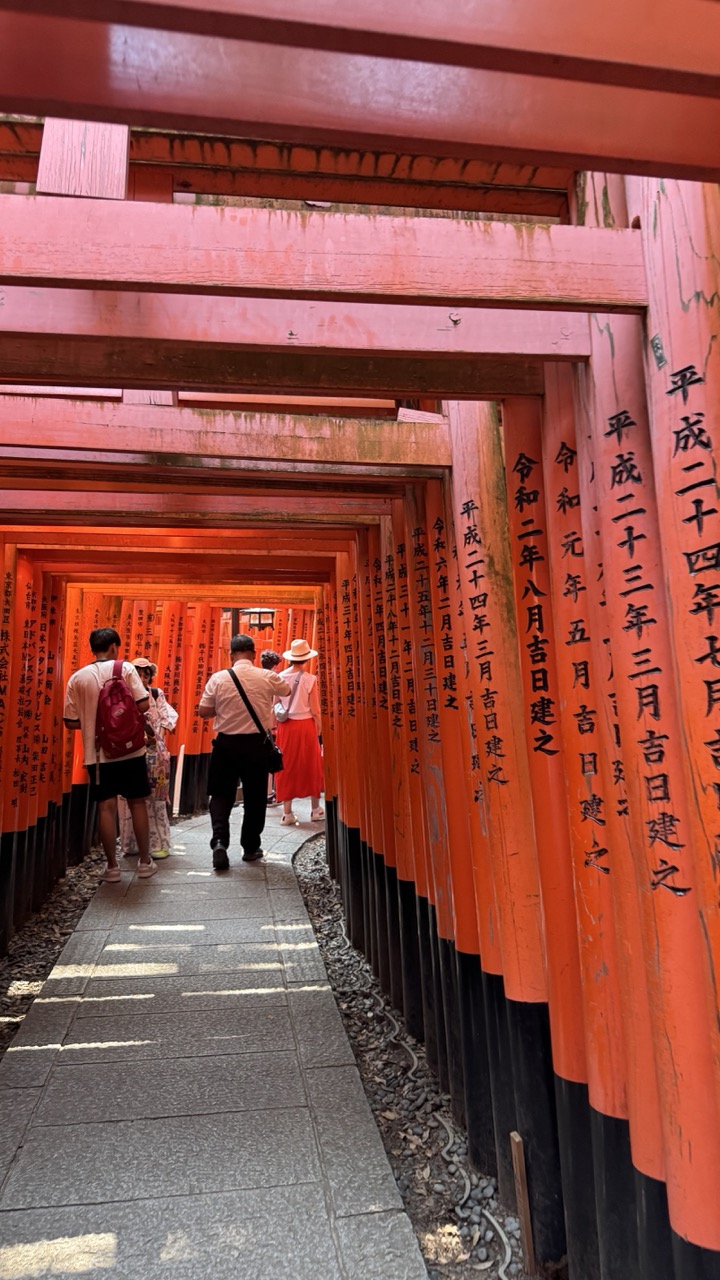

1. Overall Rating (0–10) — 7.5
This photograph captures the immersive journey through the iconic vermilion torii gates of Fushimi Inari Shrine, where tradition and tourism converge in a vivid corridor of color and culture. The repeating lines of the gates create a powerful sense of depth and rhythm, drawing the eye into the heart of the shrine. While the presence of tourists grounds the scene in reality, it slightly disrupts the spiritual serenity one might expect—yet this juxtaposition adds a layer of contemporary relevance to the timeless architecture.
2. Composition (0–10) — 8.0
The strong leading lines of the torii gates create a compelling perspective, guiding the viewer’s gaze through the frame. The placement of the figures near the lower third adds scale and narrative, while the symmetry of the arches enhances visual harmony and balance.
3. Lighting (0–10) — 7.0
Natural daylight filters through the gates, casting soft, elongated shadows that enhance the sense of depth. The warm, ambient glow highlights the rich red-orange hue of the wood, though the overhead light slightly flattens the scene in the upper portions.
4. Color & Tone (0–10) — 8.5
The bold, saturated vermilion of the torii stands out against the muted gray stone path, creating a striking contrast. The consistent color palette reinforces the visual rhythm of the scene, while the black inscriptions on the gates add textural and tonal variation.
5. Creativity (0–10) — 7.5
The photograph captures a well-known cultural landmark with a strong sense of place, but the inclusion of modern visitors adds a layer of narrative that feels both grounded and slightly disruptive. The image succeeds by transforming a tourist moment into a contemplative passage.
6. Technical Quality (0–10) — 8.0
The image is sharp and clear, with good detail in both the foreground and background. Focus is well-managed, and the exposure is balanced, preserving the integrity of the colors and textures.
7. Emotional Impact (0–10) — 7.0
There’s a quiet sense of wonder in walking through the tunnel of gates, and the photo evokes a feeling of pilgrimage and connection to tradition. The presence of others adds a human element, making the experience feel both intimate and shared.
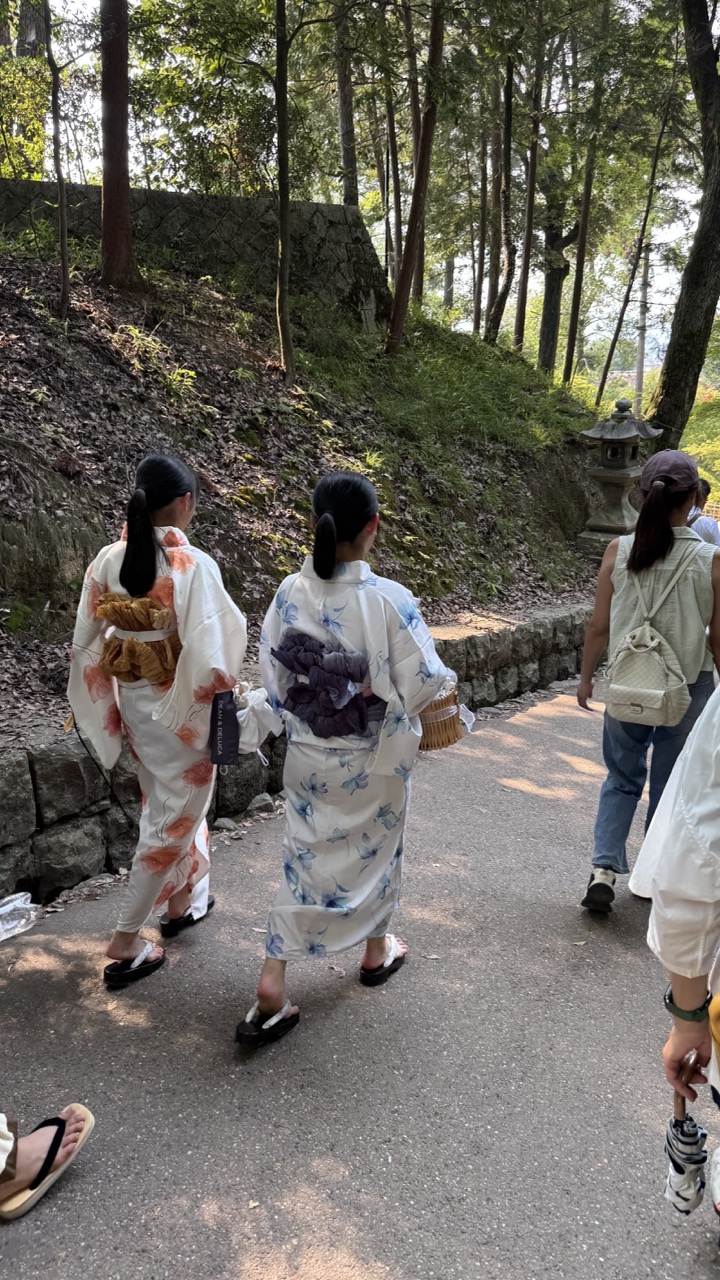

1. Overall Rating (0–10) — 6.0
This photograph captures a quiet, candid moment of cultural immersion, with two women in traditional kimonos walking along a forested path, their backs to the camera. The natural setting and relaxed pace convey a sense of journey and tradition, though the composition feels slightly unbalanced and the image lacks a strong focal point. While the scene is rich with cultural context, the overall impact is muted by a lack of visual cohesion and emotional depth.
2. Composition (0–10) — 5.5
The framing is slightly off-center, with the main subjects positioned too low and crowded by the foreground elements. The path leads the eye diagonally through the frame, but the inclusion of multiple figures and objects—especially the partial view of feet and a bag—distracts from the central narrative.
3. Lighting (0–10) — 6.0
Natural daylight filters through the trees, creating soft, dappled light that enhances the tranquil mood. However, the exposure is uneven, with some areas underexposed and others slightly washed out, reducing overall clarity and tonal richness.
4. Color & Tone (0–10) — 6.5
The color palette is grounded in natural tones—greens, grays, and earthy whites—with the floral patterns of the kimonos adding subtle pops of color. The tones are somewhat muted, and the overall image lacks vibrancy, though the contrast between the traditional attire and the modern backpacks introduces a subtle narrative tension.
5. Creativity (0–10) — 6.0
The image captures a compelling cultural juxtaposition—traditional dress in a contemporary, everyday setting—but the execution feels more documentary than artistic. The moment is genuine, yet the lack of intentional framing or thematic emphasis limits its creative impact.
6. Technical Quality (0–10) — 6.5
The image is reasonably sharp, with clear details in the kimonos and surroundings. However, focus is inconsistent, with some elements slightly soft, and the low-angle framing introduces technical imperfections in depth and balance.
7. Emotional Impact (0–10) — 5.5
The photograph evokes a sense of peaceful passage and cultural continuity, but the viewer’s connection is hindered by the casual, unposed nature of the shot. While it hints at a deeper story, the emotional resonance remains surface-level, leaving the viewer as an observer rather than a participant.
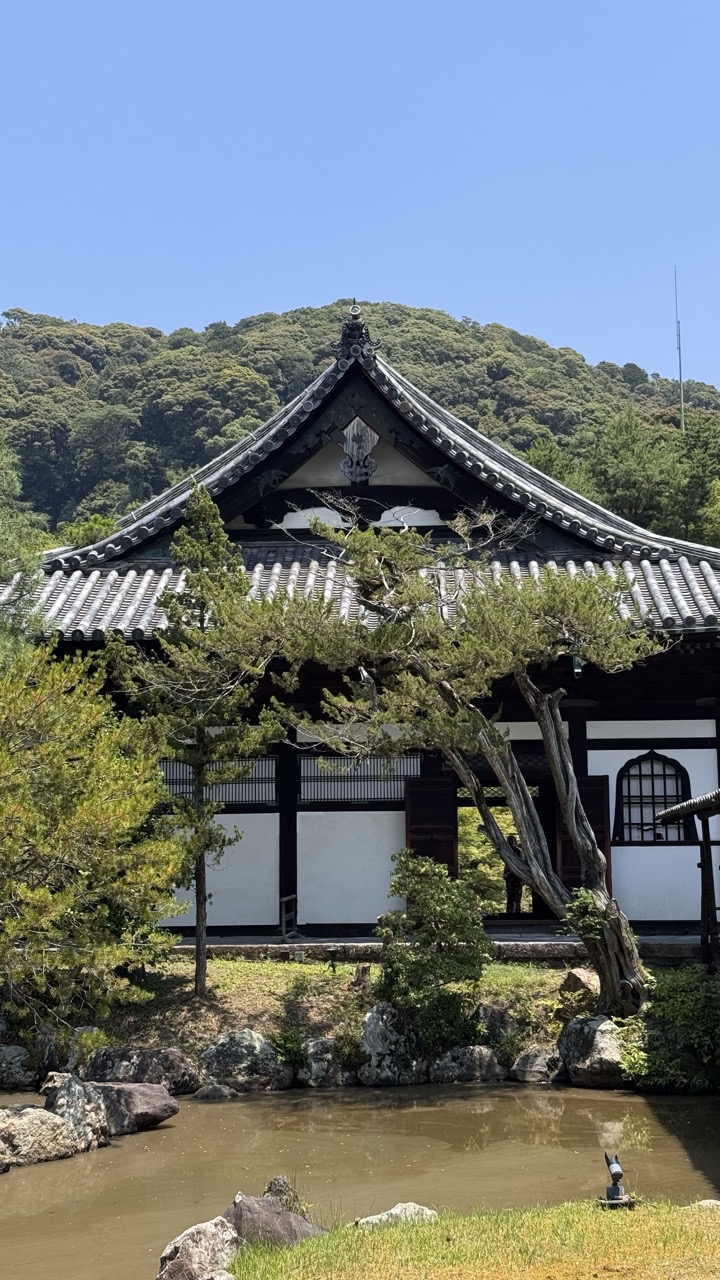

1. Overall Rating (0–10) — 8.0
This photograph captures the serene harmony of a traditional Japanese temple nestled within a lush, natural landscape. The crisp contrast between the temple’s clean lines and the organic forms of the surrounding trees and water creates a sense of balance and timelessness. While the image is visually compelling and rich in cultural resonance, the slightly cluttered foreground and overexposed sky slightly diminish its overall refinement.
2. Composition (0–10) — 8.0
The temple is centered with a strong vertical alignment, drawing the eye upward, while the foreground pond and rocks create a layered depth. The leaning tree adds a dynamic diagonal that guides the viewer’s gaze without disrupting the composition’s calm.
3. Lighting (0–10) — 8.5
Bright, direct sunlight enhances the clarity of architectural details and textures, casting soft shadows that add dimension. The high contrast between the white walls and dark eaves is accentuated by the clear blue sky, creating a striking visual balance.
4. Color & Tone (0–10) — 8.0
The palette is rich yet restrained—deep greens of the trees, the crisp white and black of the temple, and the earthy brown of the pond create a natural harmony. The vibrant blue sky provides a vivid backdrop without overpowering the scene.
5. Creativity (0–10) — 7.5
The image captures a classic aesthetic with a strong sense of place, but its strength lies more in its authenticity than in bold artistic interpretation. The framing and timing suggest a thoughtful approach to documenting the site rather than reinventing its visual narrative.
6. Technical Quality (0–10) — 8.5
Sharp focus across the frame, excellent clarity, and well-balanced exposure contribute to a technically polished image. The details in the roof tiles and wood grain are well preserved.
7. Emotional Impact (0–10) — 8.0
The photograph evokes a deep sense of peace and contemplation, inviting the viewer into a quiet moment of cultural and natural beauty. The stillness of the water and the timeless architecture foster a meditative atmosphere.
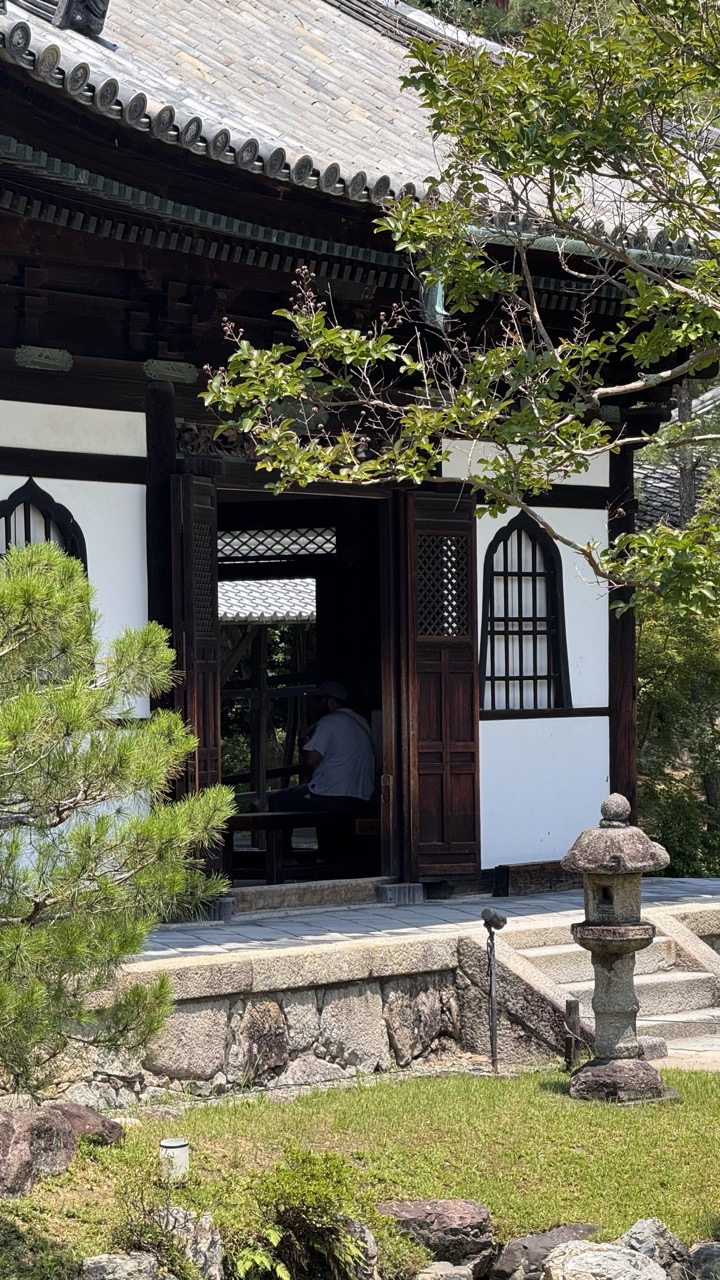

1. Overall Rating (0–10) — 7.5
This photograph captures a serene moment at a traditional Japanese temple, where architecture, nature, and quiet human presence converge in harmonious balance. The interplay of light and shadow, combined with the natural framing of the tree branches, lends a contemplative mood to the scene. While the image is visually rich and evocative, the slightly overexposed sky and muted tones prevent it from achieving a more refined aesthetic.
2. Composition (0–10) — 7.0
The subject is well-centered within the frame, with the open doorway drawing the eye into the interior. The foreground elements—stone lantern, pine, and foliage—create depth and guide the viewer’s gaze. However, the composition feels slightly cluttered due to the overlapping branches and the asymmetrical placement of the lantern.
3. Lighting (0–10) — 7.0
Natural daylight illuminates the scene evenly, with soft shadows enhancing the textures of wood and stone. The contrast between the bright exterior and the dark interior adds visual interest, though the sky is slightly overexposed, losing detail in the upper portion of the image.
4. Color & Tone (0–10) — 6.5
The palette is dominated by earthy greens, whites, and browns, creating a natural and calming atmosphere. However, the colors appear slightly washed out, with the greens lacking vibrancy and the whites appearing slightly flat under the bright sunlight.
5. Creativity (0–10) — 7.5
The photograph successfully captures a moment of stillness and tradition, blending architectural detail with organic elements in a way that feels both authentic and artistic. The inclusion of the figure within the temple adds a subtle narrative, inviting curiosity about the space and its purpose.
6. Technical Quality (0–10) — 7.5
The image is sharp and well-focused, particularly on the temple structure and lantern. The depth of field is appropriate, keeping the foreground and midground in clear view while gently blurring the background. The exposure is mostly balanced, though minor overexposure in the sky reduces overall technical refinement.
7. Emotional Impact (0–10) — 8.0
The image evokes a sense of peace and reverence, inviting the viewer to pause and reflect. The quiet presence of the figure, the aged stone, and the lush greenery combine to create a deeply meditative and introspective atmosphere.
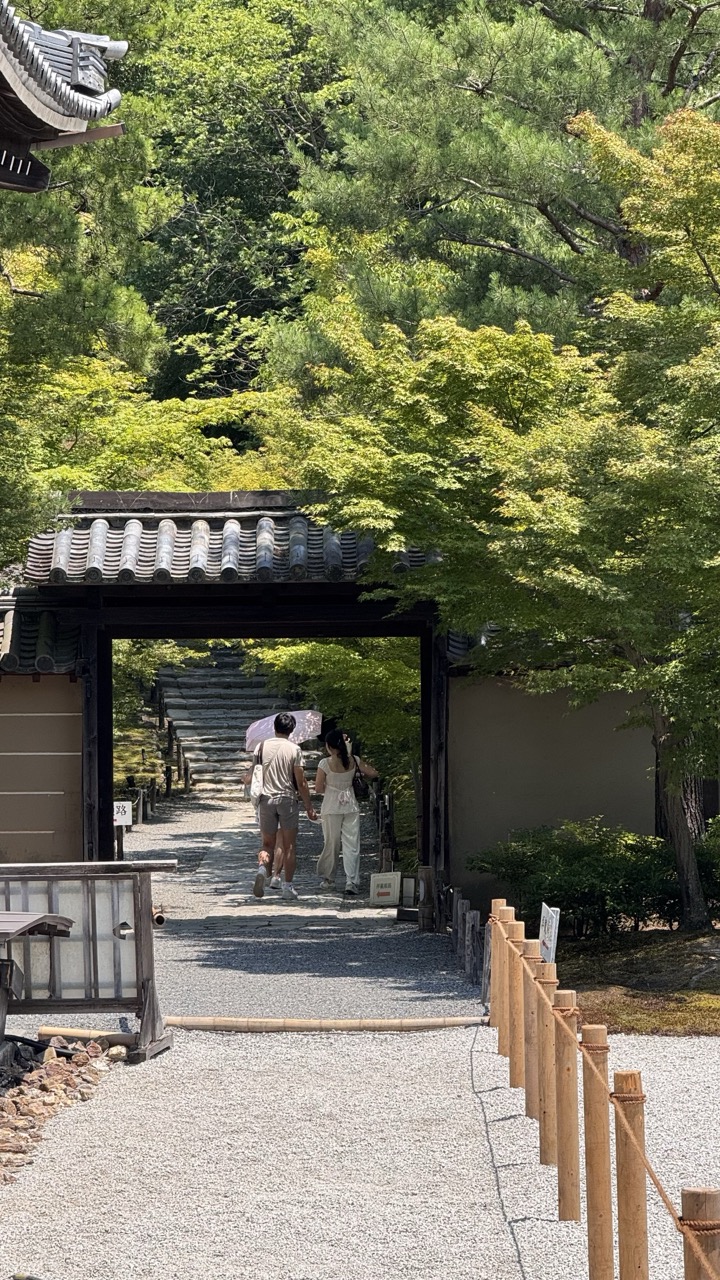

1. Overall Rating (0–10) — 7.0
This photograph captures the serene rhythm of a traditional Japanese garden, where the interplay of nature and architecture evokes a sense of calm and contemplation. The couple walking through the gate adds a human element that grounds the scene in quiet movement, while the lush greenery and gravel path enhance the meditative atmosphere. While the image is visually rich and harmonious, its potential is slightly restrained by a lack of strong focal contrast and dynamic lighting.
2. Composition (0–10) — 7.5
The composition uses the gate as a natural frame, drawing the eye into the path and creating a sense of depth. The placement of the couple near the center, walking away, guides the viewer’s gaze through the scene. The diagonal line of the gravel path and the wooden railing on the right add subtle structure, though the slightly off-center framing of the gate introduces a minor imbalance.
3. Lighting (0–10) — 7.0
Natural daylight filters through the trees, creating soft dappled shadows that enhance texture and depth. The bright sunlight highlights the vibrant green foliage, while the shaded areas under the gate add contrast. The lighting is consistent and clear, though the overall exposure leans slightly toward the brighter side, slightly flattening the tonal range in the highlights.
4. Color & Tone (0–10) — 7.5
The palette is dominated by rich, natural greens and earthy tones of wood and stone, creating a cohesive and tranquil atmosphere. The contrast between the light gravel and dark wooden gate adds visual interest. A subtle warmth in the sunlight enhances the organic feel, and the cool gray of the tiled roof provides a grounding counterpoint.
5. Creativity (0–10) — 7.0
The image successfully blends traditional Japanese aesthetics with a contemporary human presence, suggesting a narrative of journey and reflection. The use of the gate as a framing device is a strong compositional choice, and the inclusion of the couple adds a layer of storytelling. While the concept is familiar, the execution feels thoughtful and evocative.
6. Technical Quality (0–10) — 8.0
The image is sharp and well-focused, with clean details in the foliage, gravel, and architectural elements. The exposure is balanced, and the camera appears to be steady, resulting in a clear and visually pleasing image. The depth of field is appropriate, keeping both the foreground and background in focus.
7. Emotional Impact (0–10) — 7.5
The photograph evokes a sense of peace and introspection, inviting the viewer to imagine walking through the gate into a quiet, timeless space. The human figures, though small, add a touch of warmth and relatability, enhancing the emotional resonance. The natural beauty and stillness of the scene create a contemplative mood that lingers.
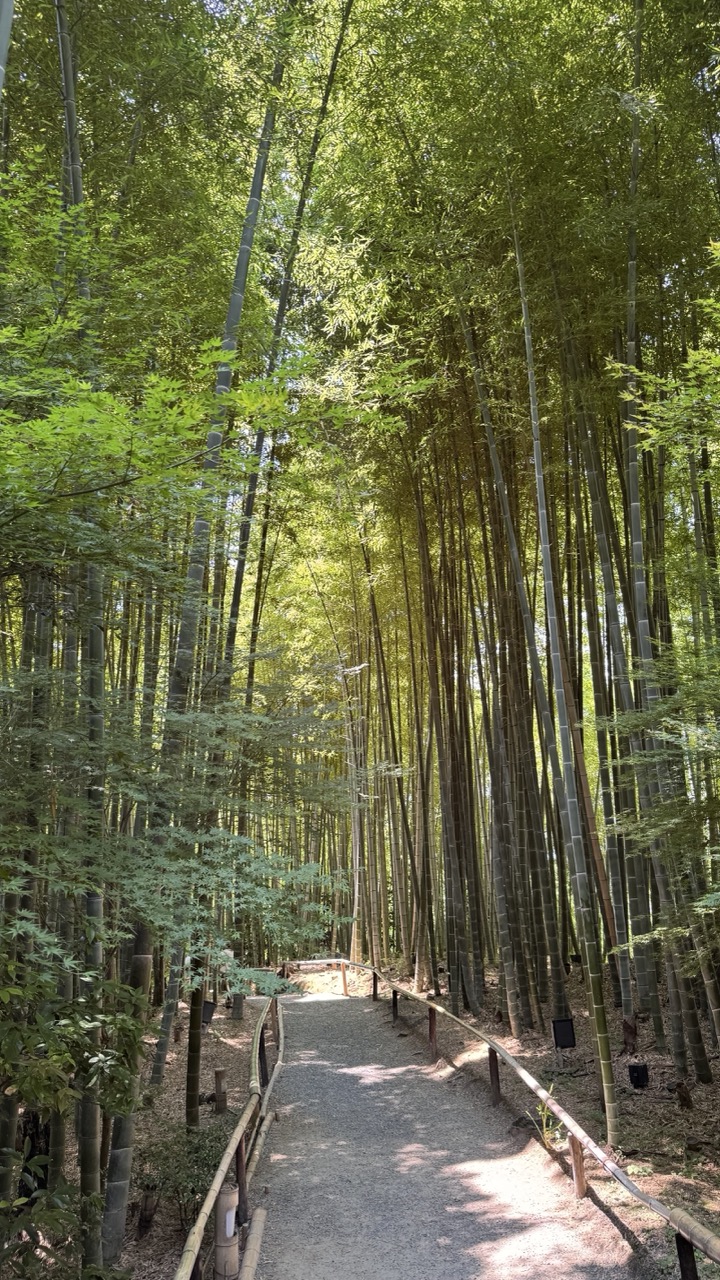

1. Overall Rating (0–10) — 7.5
This photograph captures the serene majesty of a bamboo grove, where sunlight filters through the dense canopy to create a luminous, meditative atmosphere. The path invites the viewer into the scene, offering a sense of quiet exploration and natural harmony. While the image is visually soothing and well-composed, it lacks a strong focal point or narrative tension, resulting in a beautiful but somewhat passive experience.
2. Composition (0–10) — 7.0
The path leads the eye naturally into the frame, creating a strong sense of depth and perspective. The bamboo stalks form vertical lines that enhance the upward reach of the scene, though the composition feels slightly unbalanced due to the denser foliage on the left.
3. Lighting (0–10) — 8.0
Dappled sunlight filters through the canopy, creating a dynamic interplay of light and shadow that adds texture and dimension. The soft, diffused quality of the light enhances the peaceful mood and highlights the vibrant green tones of the bamboo.
4. Color & Tone (0–10) — 7.5
The palette is dominated by lush greens and earthy browns, with subtle variations in tone that give the image a natural, organic feel. The contrast between the bright highlights and shaded areas adds visual interest, though the colors remain relatively restrained.
5. Creativity (0–10) — 6.5
The image is a classic representation of a tranquil bamboo forest, capturing its timeless beauty with clarity and precision. While it lacks a distinctive artistic twist, its strength lies in its simplicity and ability to evoke a sense of calm.
6. Technical Quality (0–10) — 8.0
The image is sharp and well-focused, with clear detail in the bamboo stalks and ground. The exposure is balanced, preserving texture and depth without harsh overexposure or underexposure.
7. Emotional Impact (0–10) — 7.0
The photograph evokes a deep sense of peace and introspection, inviting the viewer to imagine walking through the quiet grove. The natural beauty and stillness of the scene resonate emotionally, though the lack of human presence or narrative element tempers the connection.
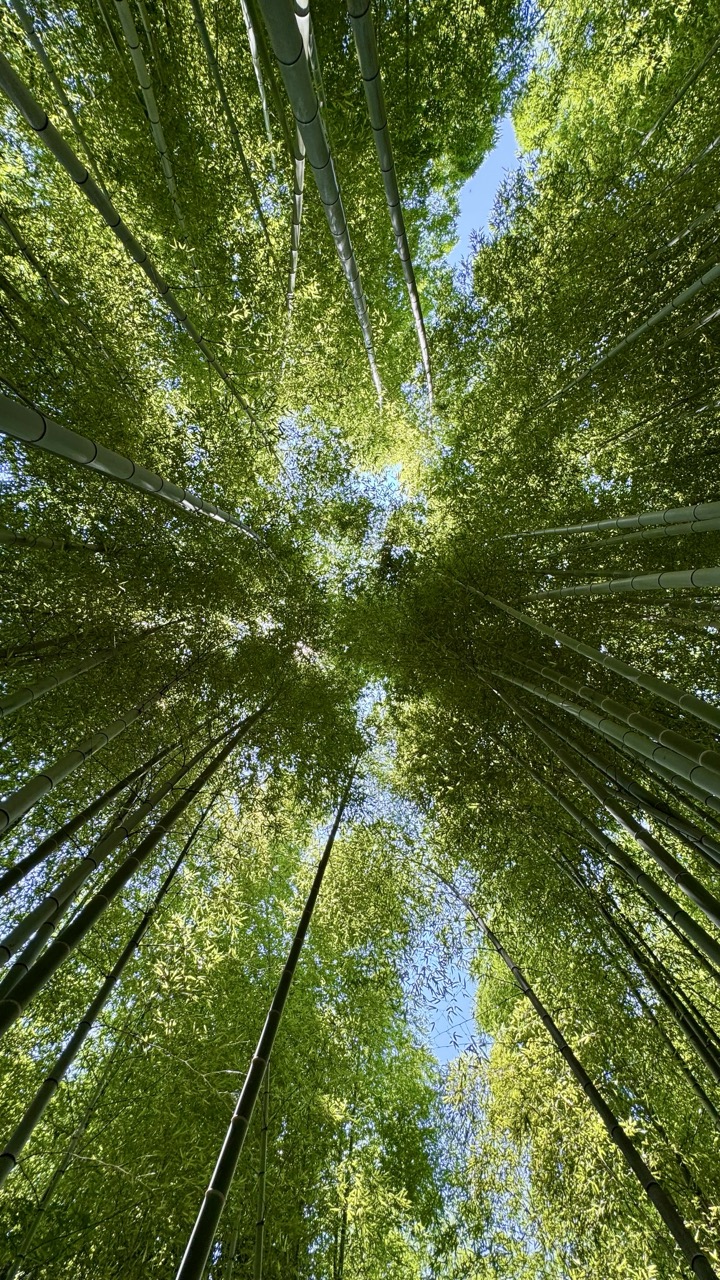

1. Overall Rating (0–10) — 8.0
This photograph captures the serene majesty of a bamboo grove from a low-angle perspective, transforming the towering stalks into a natural cathedral that draws the eye upward. The interplay of light and shadow through the dense canopy creates a sense of depth and tranquility, while the vibrant green hues evoke renewal and calm. The image is strong in mood and composition, though the slightly overexposed sky detracts from the overall harmony.
2. Composition (0–10) — 9.0
The upward-looking angle creates a powerful sense of verticality and scale, with the bamboo stalks converging toward the center of the frame to form a dynamic radial composition. The symmetry and repetition of the culms guide the viewer’s gaze naturally toward the sky, enhancing the feeling of awe.
3. Lighting (0–10) — 7.5
Bright, natural sunlight filters through the canopy, creating dappled patterns and highlighting the texture of the leaves. The light enhances the lushness of the greenery, though the overexposed patches of sky reduce detail and create a slight imbalance in exposure.
4. Color & Tone (0–10) — 8.5
The palette is dominated by rich, varying shades of green, from deep forest tones to luminous lime, contrasted with the pale blue of the sky. The colors are vibrant and harmonious, contributing to the image’s refreshing and immersive quality.
5. Creativity (0–10) — 8.0
The choice of perspective and the framing of the bamboo grove as an upward-reaching canopy reflect a thoughtful and imaginative approach. The photograph transforms a natural scene into a meditative visual experience, evoking both the beauty and the quiet power of nature.
6. Technical Quality (0–10) — 8.0
The image is sharp and well-focused, with clear detail in the bamboo culms and foliage. The camera’s wide-angle perspective is used effectively to capture the vastness of the grove, though minor lens distortion is present at the edges.
7. Emotional Impact (0–10) — 8.5
The photograph evokes a deep sense of peace and connection to nature, inviting the viewer to pause and reflect. The immersive viewpoint and calming colors create a meditative atmosphere that resonates with quiet contemplation and wonder.
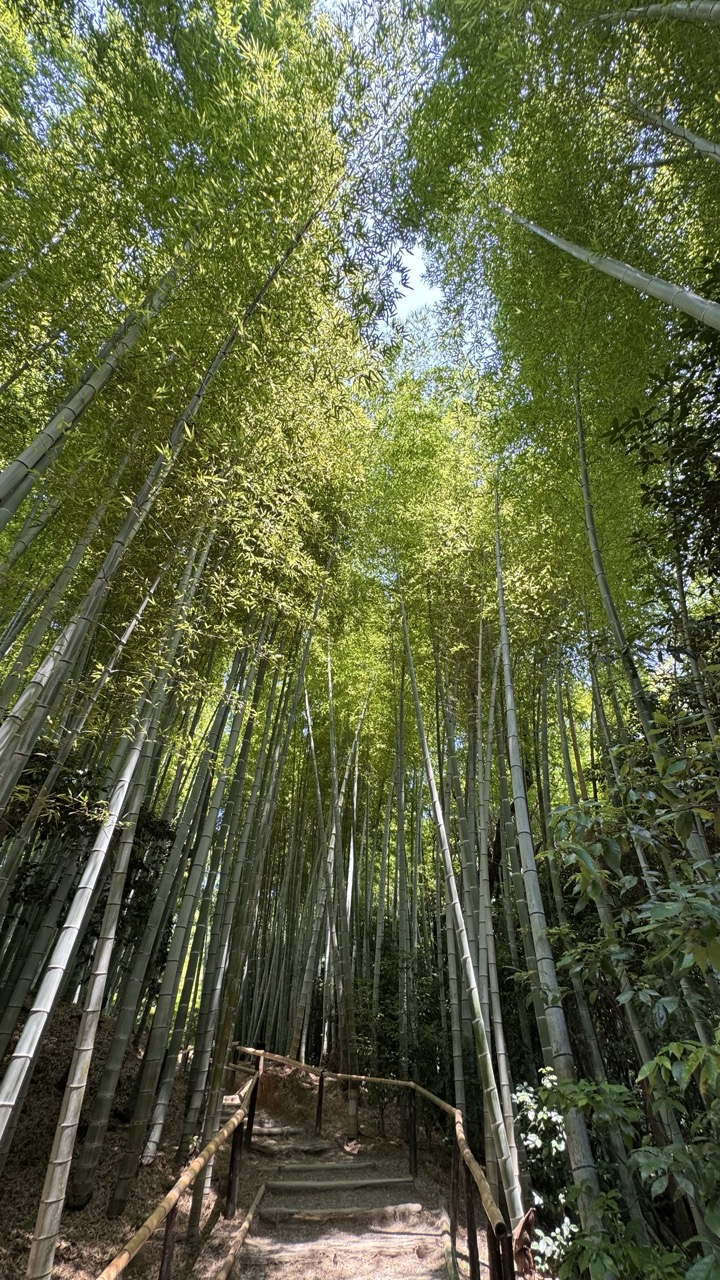

1. Overall Rating (0–10) — 8.0
This photograph captures the serene majesty of a bamboo forest, where towering culms rise like natural columns toward a dappled sky. The upward perspective immerses the viewer in the quiet grandeur of the grove, evoking a sense of peace and vertical harmony. While the image is visually compelling, the slightly overexposed sky and uneven lighting slightly detract from its overall refinement.
2. Composition (0–10) — 8.5
The low-angle view emphasizes the height and density of the bamboo, creating a strong sense of scale and depth. The winding path and handrail lead the eye naturally upward, enhancing the feeling of ascent and exploration. The framing is balanced, with the forest enveloping the scene on all sides.
3. Lighting (0–10) — 7.0
Natural daylight filters through the canopy, casting soft highlights and shadows that accentuate the texture of the bamboo stalks. However, the bright sky at the top is slightly overexposed, losing detail in the upper foliage and creating a subtle contrast imbalance.
4. Color & Tone (0–10) — 8.0
The palette is dominated by lush greens and earthy browns, creating a natural and calming tone. The vibrant green of the leaves contrasts beautifully with the pale, sunlit bamboo, while the overall tonal range is rich and harmonious.
5. Creativity (0–10) — 8.0
The choice of a low-angle perspective transforms a simple forest path into a dramatic, almost spiritual journey. The image captures not just a place, but a mood—reverence for nature and the quiet awe of being surrounded by ancient growth.
6. Technical Quality (0–10) — 8.0
The image is sharp and well-focused, with clear detail in the bamboo stalks and foliage. The camera’s exposure is generally well-handled, though minor overexposure in the sky suggests room for adjustment in dynamic range.
7. Emotional Impact (0–10) — 8.5
The photograph evokes a deep sense of tranquility and wonder, inviting the viewer to step into the hushed stillness of the forest. The immersive composition and natural beauty create a powerful emotional connection to nature’s quiet strength.
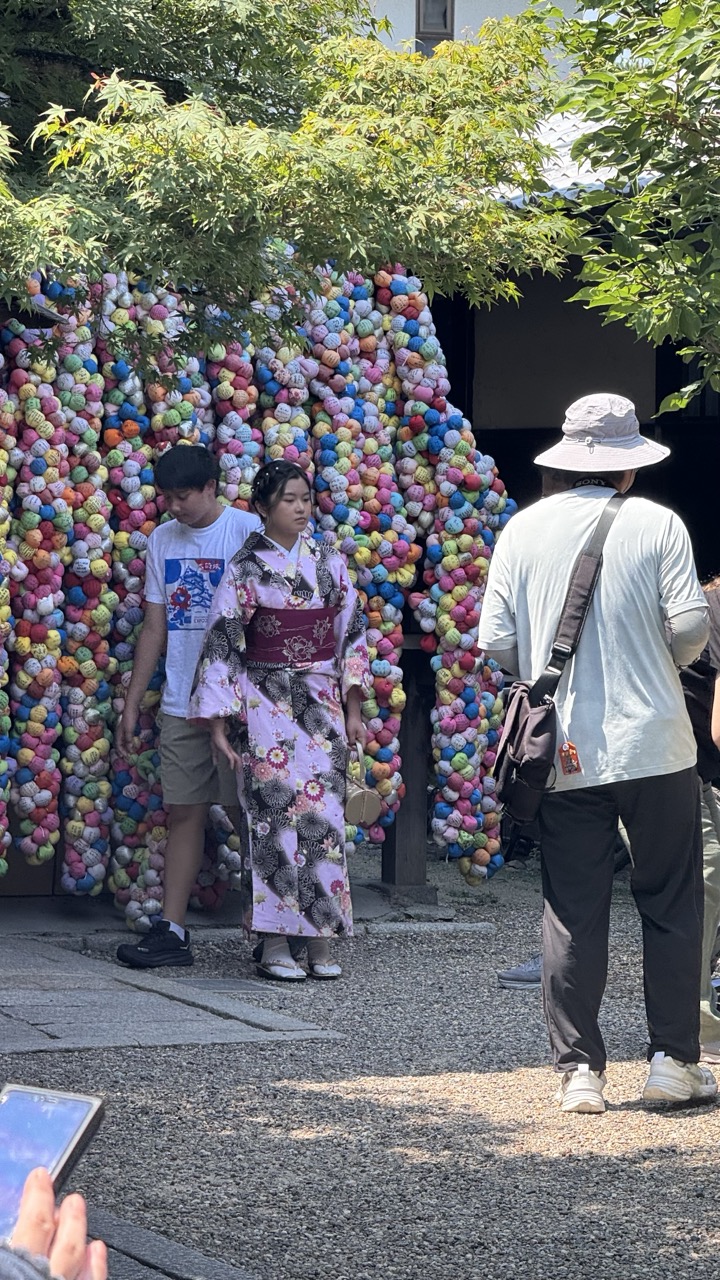

1. Overall Rating (0–10) — 6.8
This photograph captures a vibrant cultural moment, where traditional Japanese attire contrasts playfully with the modern, whimsical backdrop of a yarn-covered structure. The scene feels candid and alive, with the juxtaposition of the kimono-clad woman and the casual tourists lending a sense of authenticity and humor. While the composition is engaging and the colors are rich, the image lacks a cohesive focal point, slightly diluting its narrative power.
2. Composition (0–10) — 6.0
The framing is slightly cluttered, with the foreground hand and phone partially obstructing the view. The central figure—the woman in the kimono—is well-placed, but the presence of multiple figures and the dense, colorful background create visual competition, reducing compositional clarity.
3. Lighting (0–10) — 7.5
Natural daylight illuminates the scene evenly, highlighting the vivid colors of the yarn and the intricate details of the kimono. The dappled sunlight filtering through the trees adds texture and depth, enhancing the overall mood.
4. Color & Tone (0–10) — 8.0
The palette is rich and dynamic, with the bright, multicolored yarns providing a playful contrast to the soft pastel tones of the kimono. The natural greens of the foliage add balance, creating a lively and harmonious color scheme.
5. Creativity (0–10) — 7.5
The image succeeds in capturing a unique cultural intersection—tradition meeting modern whimsy. The choice to photograph this moment, with its unexpected blend of formality and playfulness, demonstrates strong creative intent and a keen eye for storytelling.
6. Technical Quality (0–10) — 7.0
The focus is sharp on the central subject, and the exposure is well-balanced. However, the image shows slight softness in the background, and the presence of the phone in the lower left corner detracts from the overall professionalism.
7. Emotional Impact (0–10) — 7.0
The photograph evokes a sense of joy and curiosity, inviting viewers to wonder about the story behind the scene. The contrast between the woman’s traditional elegance and the lighthearted, colorful installation creates a moment of warmth and cultural charm.
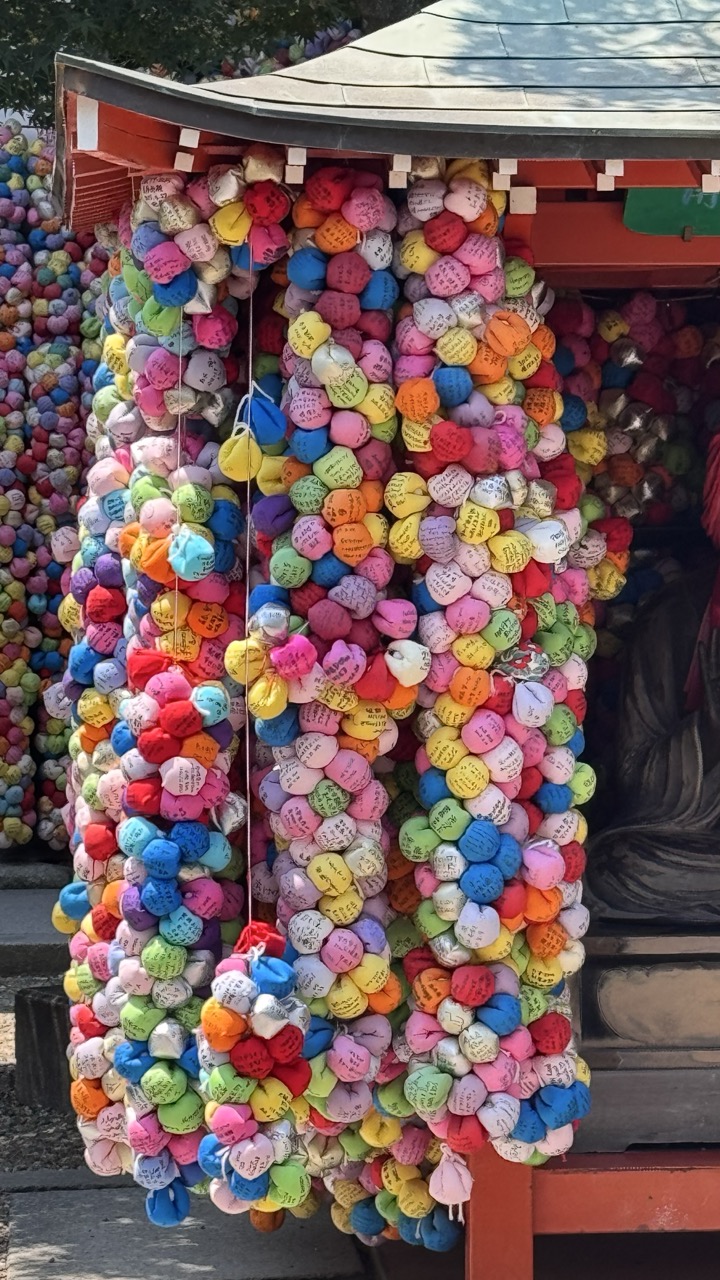

1. Overall Rating (0–10) — 7.5
This photograph bursts with color and cultural richness, capturing the vibrant tradition of omamori and omikuji at a Japanese shrine. The dense clusters of colorful, handwritten amulets create a visually dynamic and textured composition, evoking a sense of collective hope and devotion. While the sheer abundance of objects risks visual overload, the image successfully conveys the spiritual and communal energy of the site, with the red shrine structure providing a strong cultural anchor.
2. Composition (0–10) — 7.0
The framing centers on the amulets, emphasizing their abundance and variety. The vertical arrangement guides the eye upward, while the red shrine elements frame the top and right, grounding the image. Slight asymmetry adds naturalism, though tighter cropping could enhance focus.
3. Lighting (0–10) — 7.5
Bright, natural daylight illuminates the scene evenly, enhancing the vividness of the colors. The light casts soft shadows under the roof, adding depth without obscuring detail. The sunny conditions highlight the texture of the fabric and the legibility of the writing.
4. Color & Tone (0–10) — 9.0
The palette is rich and diverse, with a spectrum of bright, saturated hues—pinks, blues, yellows, and greens—creating a joyful and celebratory visual rhythm. The contrast between the colorful amulets and the deep red of the shrine adds cultural resonance and visual harmony.
5. Creativity (0–10) — 8.0
The image captures a unique cultural practice with a sense of authenticity and wonder. The choice to focus on the amulets rather than the shrine or people emphasizes the personal stories behind each wish, turning the scene into a tapestry of human hopes.
6. Technical Quality (0–10) — 8.5
The image is sharp and clear, with precise focus on the foreground amulets. The depth of field is well-managed, keeping the central elements in crisp detail while softly blurring the background. The exposure is balanced, preserving detail in both light and shadow.
7. Emotional Impact (0–10) — 8.0
The photograph evokes a sense of awe and quiet reverence, inviting the viewer to reflect on the personal and collective hopes expressed in each amulet. The colorful abundance feels both overwhelming and deeply meaningful, creating a powerful emotional resonance with the themes of faith and connection.
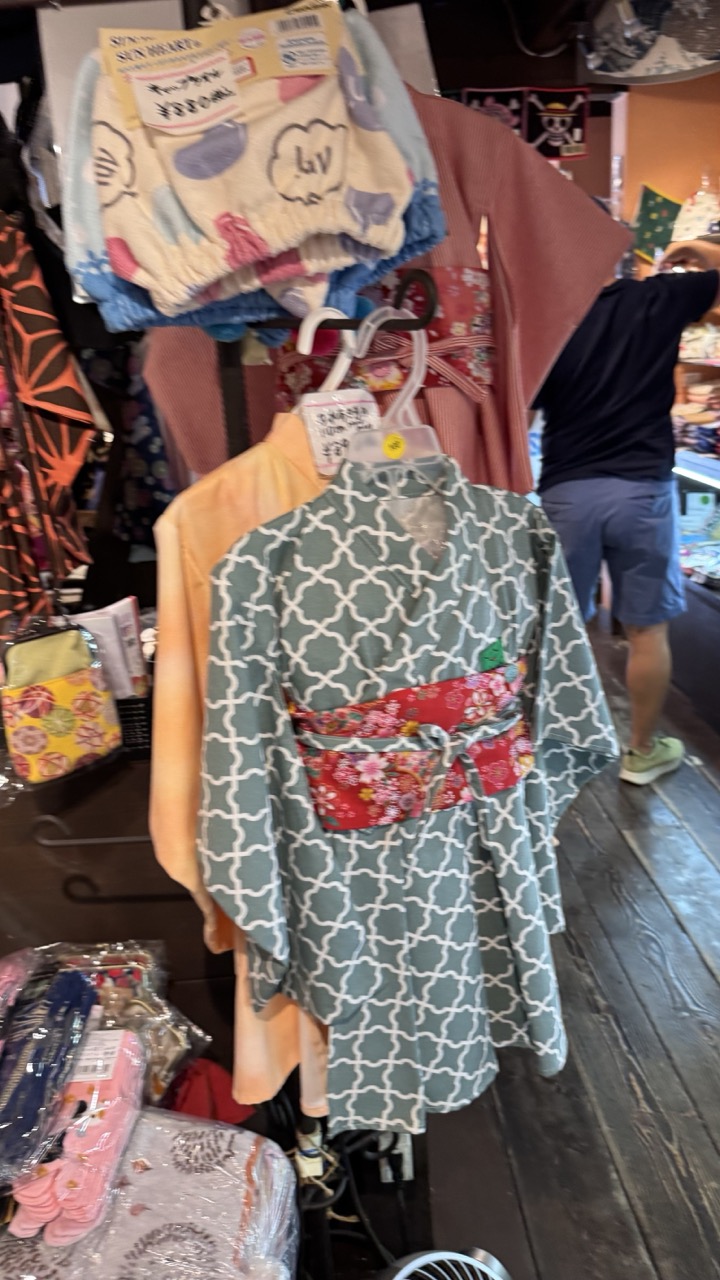

1. Overall Rating (0–10) — 5.5
This photograph captures a bustling souvenir shop with a focus on traditional Japanese attire, but the image feels more like a casual snapshot than a curated composition. The foreground kimono, with its intricate pattern and vibrant obi, draws the eye, yet the surrounding clutter and shallow depth of field dilute the visual impact. While the scene is rich with cultural context and everyday energy, the lack of focus and framing restraint keeps it from feeling fully intentional or artistically resonant.
2. Composition (0–10) — 5.0
The central kimono is well-placed but partially obscured by other garments and objects, creating visual confusion. The diagonal lines of the hanging items and the man in the background disrupt balance and lead the eye away from the focal point.
3. Lighting (0–10) — 5.0
Harsh, overhead fluorescent lighting flattens the scene, washing out subtle textures and colors. The lack of directional light results in a sterile atmosphere that fails to enhance the warmth and craftsmanship of the garments.
4. Color & Tone (0–10) — 5.5
The palette is a mix of muted and bold tones—soft greys, warm oranges, and vibrant reds—yet the colors appear dull due to the lighting. The contrast between the patterned kimono and the cluttered background creates visual noise rather than harmony.
5. Creativity (0–10) — 6.0
The image captures a slice of authentic cultural commerce, offering a glimpse into a local shop’s offerings. However, the lack of compositional control and artistic intention limits its creative expression, feeling more documentary than conceptual.
6. Technical Quality (0–10) — 6.0
The image is reasonably sharp in the foreground, but the depth of field is inconsistent, leaving both the subject and background slightly soft. The slight motion blur in the background suggests a slow shutter speed, which affects clarity.
7. Emotional Impact (0–10) — 5.0
While the scene evokes a sense of place and daily life, the emotional resonance is muted. The viewer is more likely to feel curiosity than connection, as the image lacks a clear narrative or mood to draw them in.
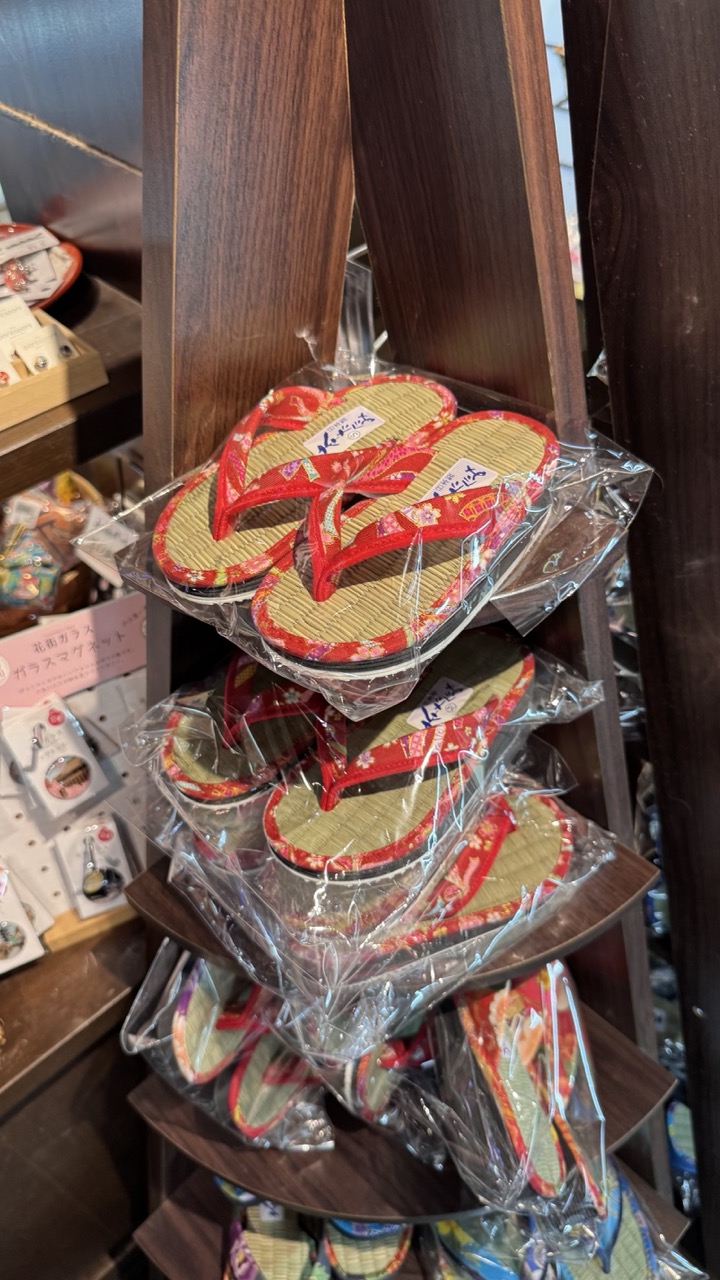

1. Overall Rating (0–10) — 6.0
This photograph captures a slice of Japanese souvenir culture, where traditional craftsmanship meets commercial display. The vibrant red and gold patterned zori sandals, neatly wrapped and arranged on a wooden rack, convey a sense of authenticity and artisanal pride. While the composition is functional and the subject clearly defined, the lack of dynamic lighting and the slightly cluttered background detract from its visual appeal, making it feel more like a casual snapshot than a curated image.
2. Composition (0–10) — 6.5
The subject is centered and well-framed, with the wooden rack creating a natural diagonal structure. However, the surrounding clutter and overlapping elements in the background slightly disrupt visual harmony.
3. Lighting (0–10) — 5.5
The lighting is flat and even, likely from overhead indoor fixtures, which reduces depth and fails to highlight the textures of the straw soles and fabric straps.
4. Color & Tone (0–10) — 7.0
The warm wood tones and bold reds of the zori create a cohesive and inviting palette, though the overall tone is slightly washed out by the artificial lighting.
5. Creativity (0–10) — 6.0
The image is straightforward and observational, capturing a real-world scene with minimal artistic manipulation. It conveys cultural context effectively but lacks a unique visual perspective.
6. Technical Quality (0–10) — 7.5
The image is sharp and clear, with good focus on the sandals. The plastic wrapping and details of the fabric are well-rendered, indicating strong technical execution.
7. Emotional Impact (0–10) — 5.0
While the subject evokes a sense of tradition and travel, the clinical presentation and lack of narrative depth limit its emotional resonance. It feels more like a record than an invitation to feel.
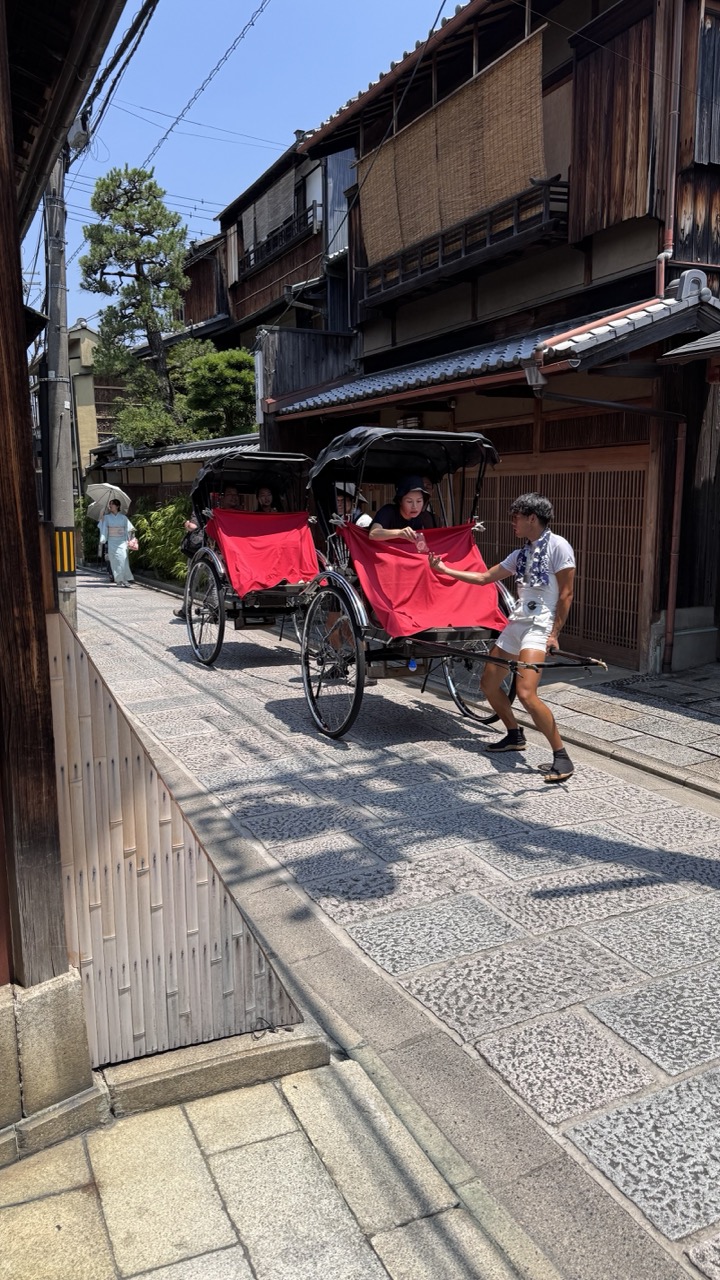

1. Overall Rating (0–10) — 7.5
This photograph captures a vibrant slice of traditional Japanese life, where the rhythmic motion of rickshaw pullers intersects with the quiet charm of a historic street. The bright sunlight and vivid red canopies create a dynamic contrast against the muted tones of the wooden buildings and stone pavement. While the scene feels authentic and alive, the composition’s slight imbalance and overexposed highlights prevent it from achieving full visual harmony.
2. Composition (0–10) — 6.5
The diagonal lines of the rickshaws and the street create a sense of movement, but the framing feels slightly off-center, with too much empty space on the left. The rickshaw puller in the foreground is well-placed, but the second rickshaw and background figure create a sense of visual clutter.
3. Lighting (0–10) — 8.0
The bright, direct sunlight enhances the scene’s energy and clarity, casting sharp shadows that add depth and texture to the stone pavement. However, the intense light leads to some overexposure in the sky and highlights on the white clothing.
4. Color & Tone (0–10) — 7.0
The palette is strong, with the bold red of the canopies standing out against the earthy browns and grays of the architecture. The warm tone of the sunlight enhances the natural colors, though the sky appears slightly washed out.
5. Creativity (0–10) — 7.5
The image captures a culturally rich moment with a sense of narrative and motion. The juxtaposition of tradition and modernity—seen in the pullers’ casual attire—adds a layer of contemporary relevance to the scene.
6. Technical Quality (0–10) — 7.5
The image is sharp and detailed, with clear focus on the rickshaw puller and passengers. The high resolution allows for fine textures in the pavement and woodwork, though some areas of the frame are slightly overexposed.
7. Emotional Impact (0–10) — 7.0
The photograph evokes a sense of movement, energy, and cultural immersion, drawing the viewer into a moment of everyday life. The human interaction—between the puller and passenger—adds a touch of warmth and connection, though the lack of a clear focal point slightly diminishes the emotional pull.
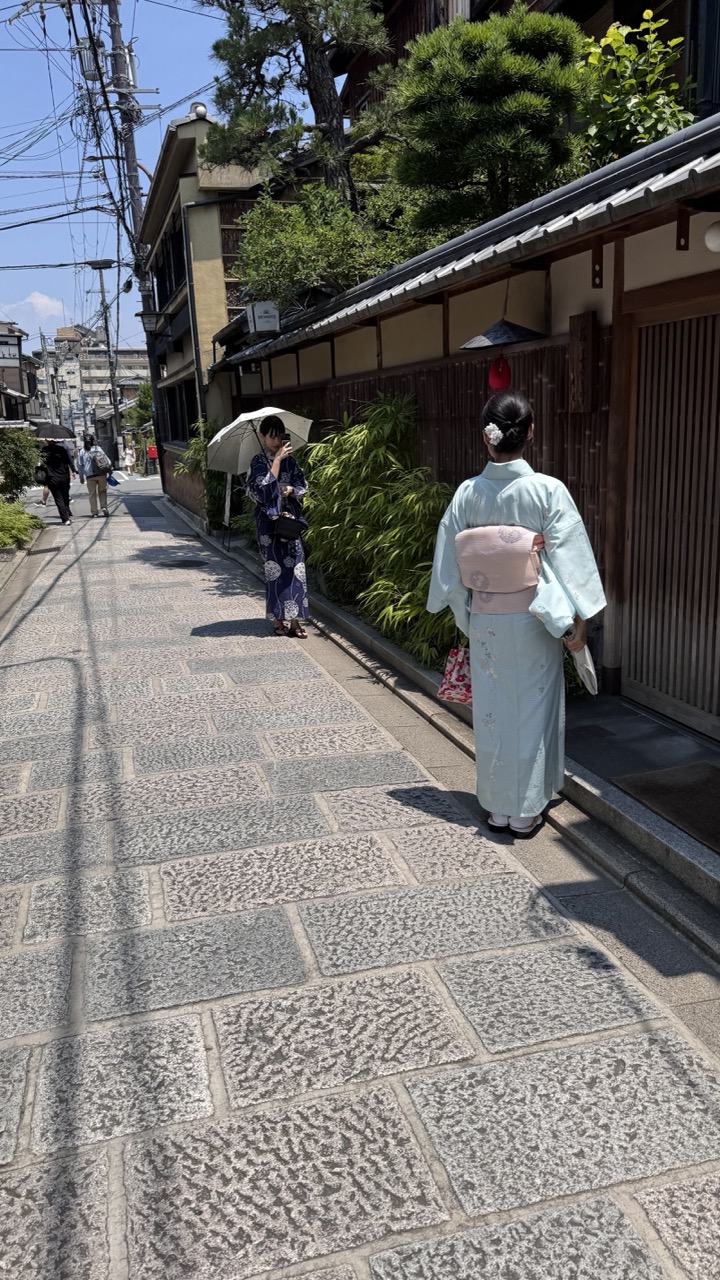

1. Overall Rating (0–10) — 7.0
This photograph captures a quiet moment on a traditional Japanese street, where the contrast between modern life and cultural preservation unfolds naturally. The composition draws the viewer into a sunlit alley lined with historic architecture and lush greenery, while the presence of two women in kimonos adds narrative depth and authenticity. Though the scene is visually rich, the lighting’s harshness slightly undermines the atmosphere, and the framing feels slightly unbalanced, preventing the image from achieving a more refined elegance.
2. Composition (0–10) — 6.5
The diagonal line of the stone path guides the eye through the frame, creating a sense of depth. However, the subject placement feels slightly awkward, with the woman in the foreground slightly off-center and the second woman partially obscured, reducing visual harmony.
3. Lighting (0–10) — 6.0
Strong overhead sunlight creates sharp shadows and high contrast, enhancing texture in the stone pavement but flattening some details in the subjects’ kimonos. The bright sky slightly overexposes the upper portion of the frame, reducing tonal range.
4. Color & Tone (0–10) — 7.0
The palette is grounded in natural, earthy tones—soft blues, muted greens, and warm beige—complemented by the subtle patterns of the kimonos. The contrast between the pale kimono and the dark wood accents adds visual interest, though the overall color temperature leans slightly cool, which slightly dampens the warmth of the scene.
5. Creativity (0–10) — 7.5
The image successfully captures a candid cultural moment, blending tradition with everyday life. The juxtaposition of traditional dress against a modern urban backdrop—complete with overhead wires—adds a subtle layer of commentary on continuity and change.
6. Technical Quality (0–10) — 7.5
The image is sharp and well-focused, with fine detail visible in the textures of the stone and fabric. The exposure is mostly balanced, though some highlights in the sky are blown out, indicating a slight overexposure.
7. Emotional Impact (0–10) — 7.0
The photograph evokes a sense of calm and introspection, inviting the viewer to imagine the quiet rhythm of daily life in a historic district. The presence of the kimonos suggests pride and continuity, while the solitary figures add a contemplative, almost nostalgic tone.
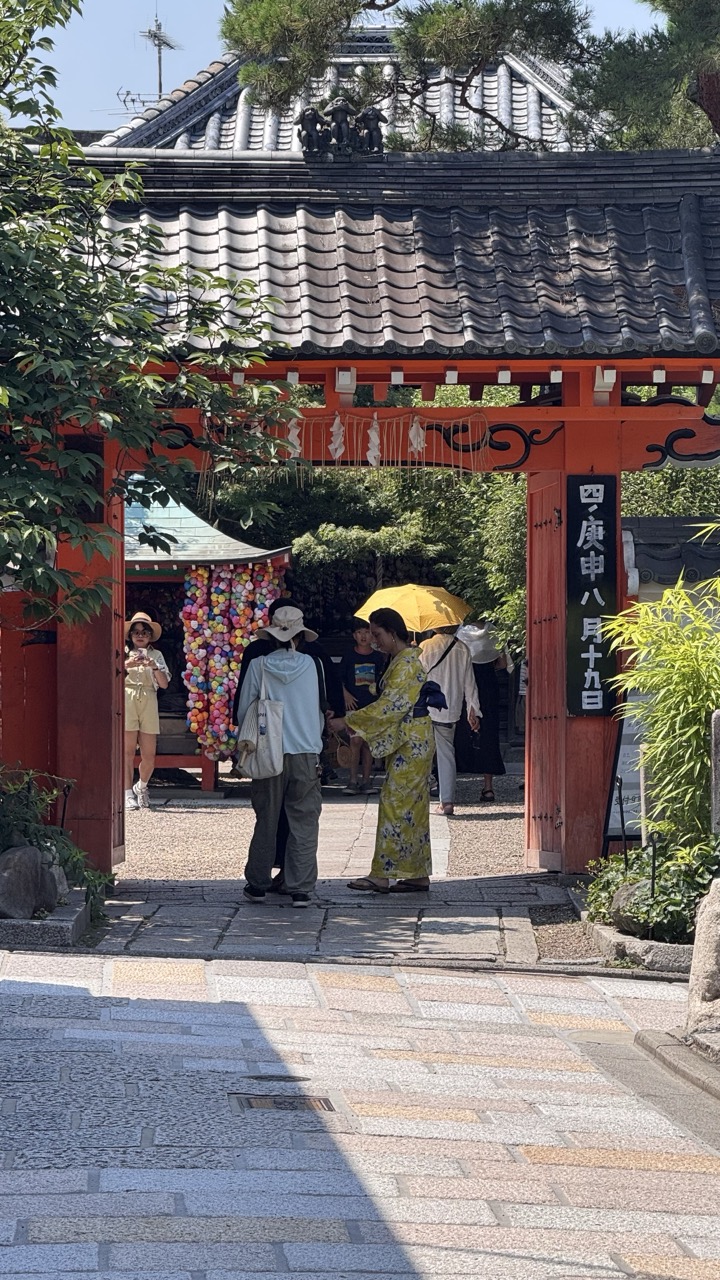

1. Overall Rating (0–10) — 7.0
This photograph captures the tranquil rhythm of a traditional Japanese shrine entrance, where cultural heritage meets everyday life. The vibrant red torii gate and the soft textures of the tiled roof create a strong visual anchor, while the mix of tourists and locals in casual and traditional attire adds a layer of authenticity and movement. The scene feels lived-in and warm, though the slightly cluttered composition and overexposed sky temper its overall aesthetic harmony.
2. Composition (0–10) — 6.5
The framing centers on the torii gate, creating a natural focal point, but the foreground stone path and scattered figures introduce visual noise. The diagonal shadow from the left adds depth, yet the off-center placement of the main subjects slightly disrupts balance.
3. Lighting (0–10) — 7.0
Bright, natural daylight enhances the vividness of the red gate and the green foliage, casting clear shadows that add dimension. However, the sky is slightly overexposed, washing out details in the upper portion of the image.
4. Color & Tone (0–10) — 7.5
The rich red of the torii contrasts beautifully with the soft greens and earthy tones of the surroundings. The color palette feels harmonious and culturally resonant, though the slightly flat tones in the midground reduce visual depth.
5. Creativity (0–10) — 7.0
The image successfully blends cultural authenticity with candid human interaction, offering a narrative glimpse into daily life at a sacred site. The inclusion of the colorful prayer beads and the woman in the kimono adds storytelling depth.
6. Technical Quality (0–10) — 7.5
Sharp focus on the central figures and gate, with clean detail in textures like the tiles and stone pavement. The exposure is generally well-managed, aside from the overexposed sky.
7. Emotional Impact (0–10) — 6.5
The scene evokes a sense of peace and reverence, enhanced by the quiet interaction between people and the spiritual setting. While it captures a moment of cultural continuity, the lack of dramatic lighting or composition keeps the emotional resonance from fully resonating.
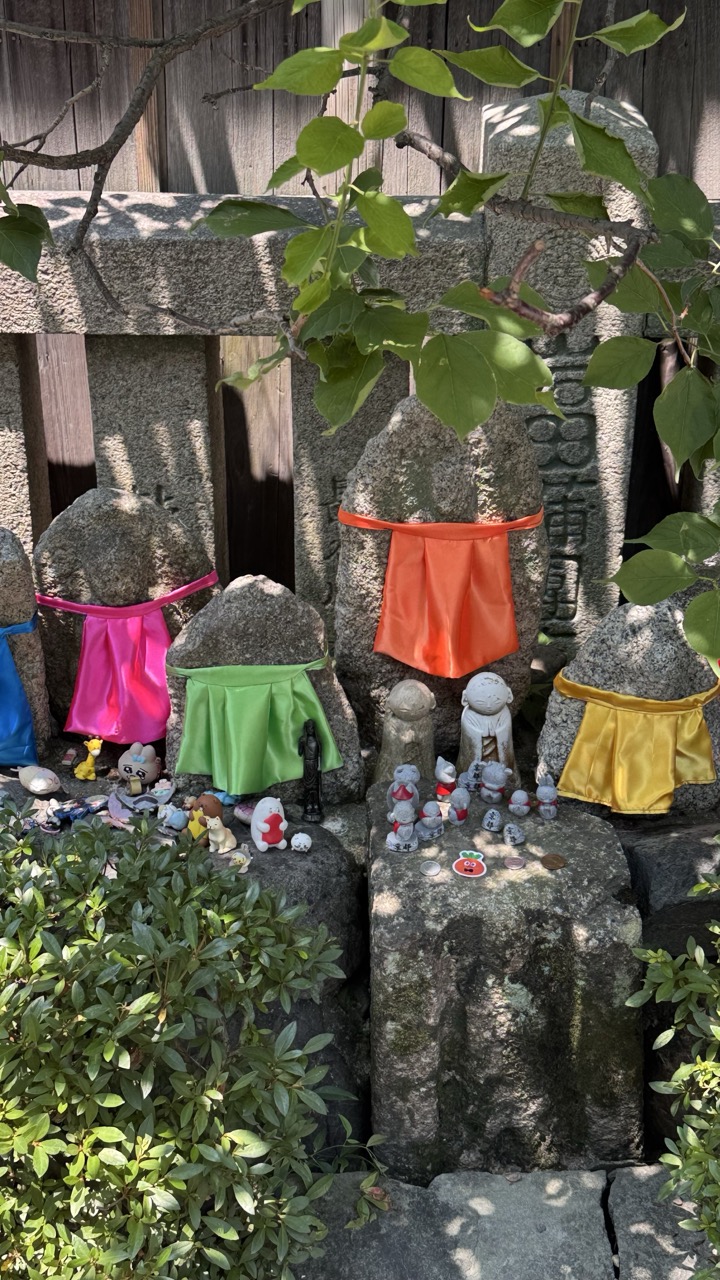

1. Overall Rating (0–10) — 7.0
This photograph captures a serene and culturally rich shrine-like arrangement, where tradition meets playful human expression through the vibrant cloth offerings and whimsical figurines. The interplay of natural light and shadow, combined with the soft green foliage, creates a contemplative atmosphere that invites curiosity. While the composition feels slightly crowded, the image succeeds in conveying a sense of devotion and quiet celebration in an everyday space.
2. Composition (0–10) — 6.5
The subject is centered but slightly off-kilter, with the foreground foliage and overhanging branches creating a natural frame that draws the eye inward. However, the abundance of small objects and uneven stone placement lends a sense of visual clutter, reducing compositional clarity.
3. Lighting (0–10) — 7.0
Natural daylight bathes the scene in soft, dappled light, creating gentle shadows that enhance texture and depth. The interplay of light and shade adds dimensionality to the stones and highlights the vivid colors of the cloths.
4. Color & Tone (0–10) — 7.5
The saturated colors of the cloth—pink, green, orange, and yellow—stand out vividly against the muted gray of the stone and the lush green leaves. The warm, earthy tones of the wood and stone provide a grounding contrast, giving the image a balanced yet lively palette.
5. Creativity (0–10) — 8.0
The juxtaposition of sacred stone figures with modern, playful toys and colorful cloths reflects a unique cultural practice, lending the image a narrative depth and originality. It captures a moment of living tradition with charm and authenticity.
6. Technical Quality (0–10) — 7.5
The image is sharp and clear, with fine detail visible in the textures of the stone, leaves, and fabric. Focus is consistent across the frame, and exposure is well-balanced, preserving detail in both highlights and shadows.
7. Emotional Impact (0–10) — 7.0
The scene evokes a quiet sense of reverence and connection, suggesting a place where people come to leave offerings and prayers—small acts of hope and care. The presence of familiar, childlike figures adds a touch of tenderness and universality to the spiritual moment.
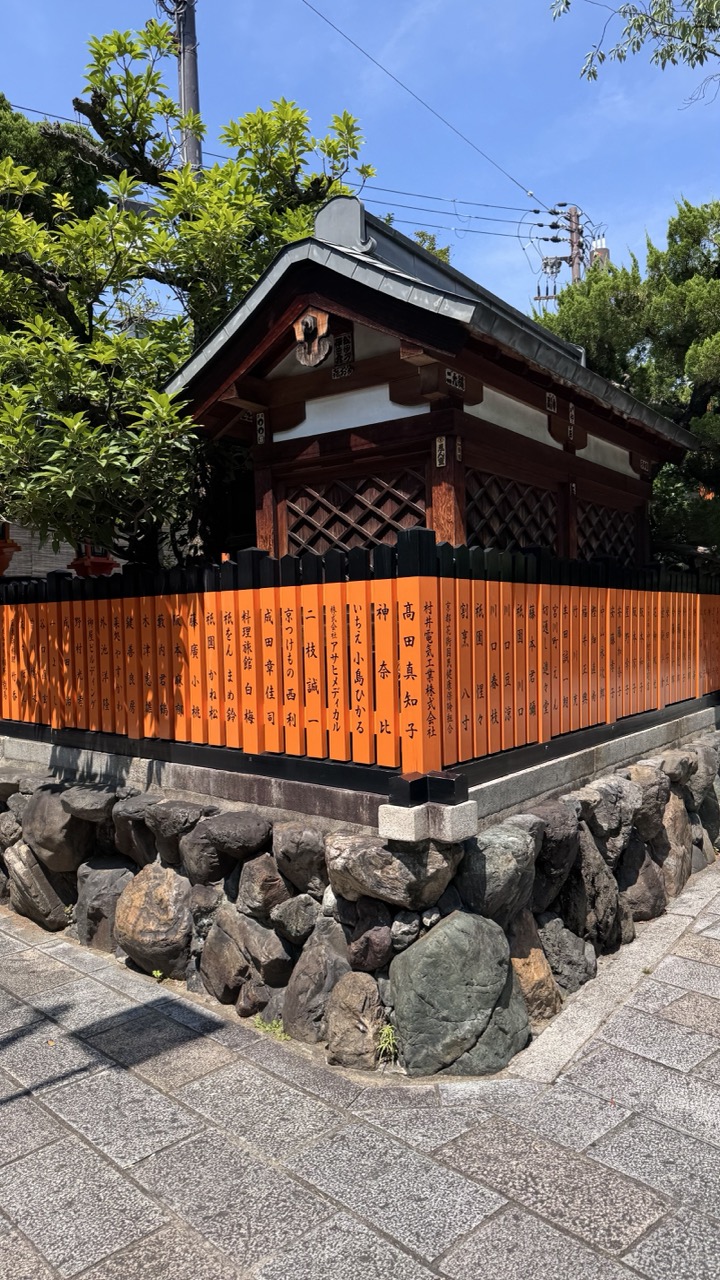

1. Overall Rating (0–10) — 7.0
This photograph captures the quiet reverence of a traditional Japanese shrine, where cultural heritage and daily life intersect under a clear blue sky. The vibrant orange prayer plaques stand in striking contrast to the weathered stone and deep green foliage, creating a visually compelling narrative of devotion and continuity. While the composition is strong and the details rich, the modern utility poles subtly intrude, reminding the viewer of the shrine’s place within a living, evolving urban environment.
2. Composition (0–10) — 7.5
The low-angle perspective emphasizes the shrine’s architectural details and the row of prayer plaques, drawing the eye along their linear arrangement. The diagonal stone wall and pavement lead the viewer’s gaze into the frame, creating a sense of depth and grounding the structure in its surroundings.
3. Lighting (0–10) — 8.0
Bright, natural daylight enhances the vividness of the orange plaques and highlights the textures of the wood and stone. The clear blue sky provides a clean backdrop, while shadows add dimension without obscuring details.
4. Color & Tone (0–10) — 8.0
The warm orange of the plaques creates a powerful focal point against the cool tones of the stone and sky. The palette is balanced and harmonious, with natural greens and browns adding depth and authenticity.
5. Creativity (0–10) — 7.0
The image successfully captures a moment of cultural significance with a sense of quiet storytelling. The juxtaposition of traditional elements with modern infrastructure adds a layer of contemporary relevance, suggesting a dialogue between past and present.
6. Technical Quality (0–10) — 8.5
The photograph is sharp and well-exposed, with excellent clarity in both the fine text on the plaques and the textures of the surrounding materials. The focus is consistent across the frame, highlighting key details without overprocessing.
7. Emotional Impact (0–10) — 7.5
The scene evokes a sense of peace and continuity, inviting reflection on the enduring nature of tradition. The presence of the prayer plaques, each inscribed with names and wishes, adds a personal and intimate dimension that resonates emotionally.
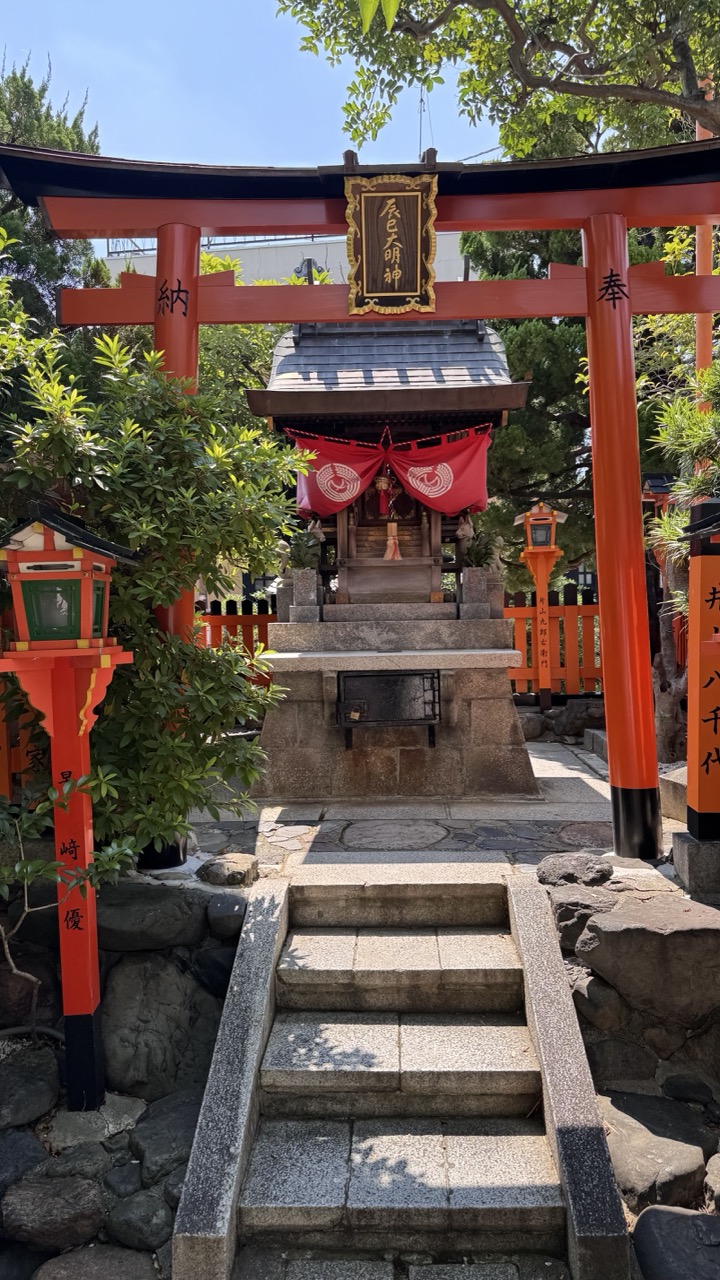

1. Overall Rating (0–10) — 7.5
This photograph captures the serene and sacred atmosphere of a Shinto shrine, where vibrant reds and natural textures create a striking visual harmony. The bold torii gate draws the eye toward the central shrine, framed by lush greenery and dappled sunlight, evoking a sense of reverence and tradition. While the composition is strong, the presence of modern buildings in the background slightly disrupts the timelessness of the scene, reminding the viewer of the shrine’s place within a contemporary urban landscape.
2. Composition (0–10) — 8.0
The central alignment of the stone steps and torii creates a strong leading line, guiding the viewer’s gaze directly to the shrine. The framing is balanced, with the red structures and green foliage creating a pleasing contrast that enhances depth and focus.
3. Lighting (0–10) — 8.0
Bright, natural sunlight enhances the vividness of the red torii and lanterns, while soft shadows add texture and dimension. The high-angle light creates a warm, inviting mood, highlighting the shrine’s details without overexposing the scene.
4. Color & Tone (0–10) — 8.0
The bold reds of the torii and lanterns stand out against the lush green foliage and the neutral gray of the stone, creating a dynamic yet harmonious palette. The warm tones evoke a sense of tradition and spirituality, while the clear blue sky adds a touch of serenity.
5. Creativity (0–10) — 7.0
The image effectively captures a moment of cultural significance, blending architectural beauty with natural elements. While the scene is familiar, the choice to frame it from the base of the steps offers a sense of reverence and perspective, inviting the viewer to step into the space.
6. Technical Quality (0–10) — 8.5
The image is sharp and well-focused, with clear details in the shrine’s architecture, the wooden plaque, and the surrounding foliage. The exposure is balanced, preserving detail in both highlights and shadows.
7. Emotional Impact (0–10) — 7.5
The photograph conveys a sense of peace and cultural reverence, inviting the viewer to pause and reflect. The combination of sacred elements and natural beauty evokes a quiet awe, making the scene feel both intimate and timeless.
Loading map...